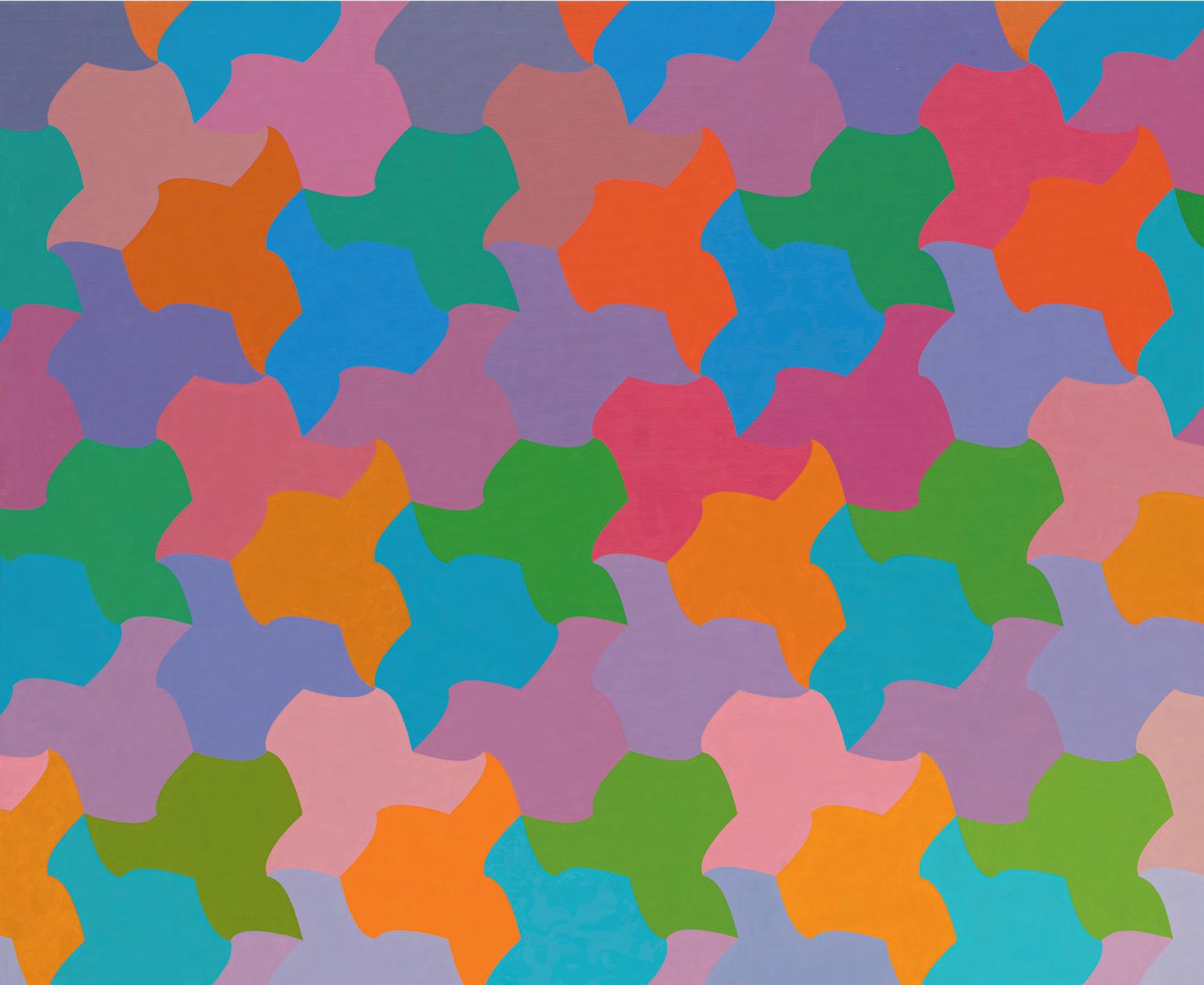

GEORGE W O O DMA N
GEORGE W O ODMAN
A DEMOCRACY OF PARTS
Paintings 19 6 6 -19 78
D C MOOR E GALLE R Y
Essay by Rebecca Skafsgaard Lowery
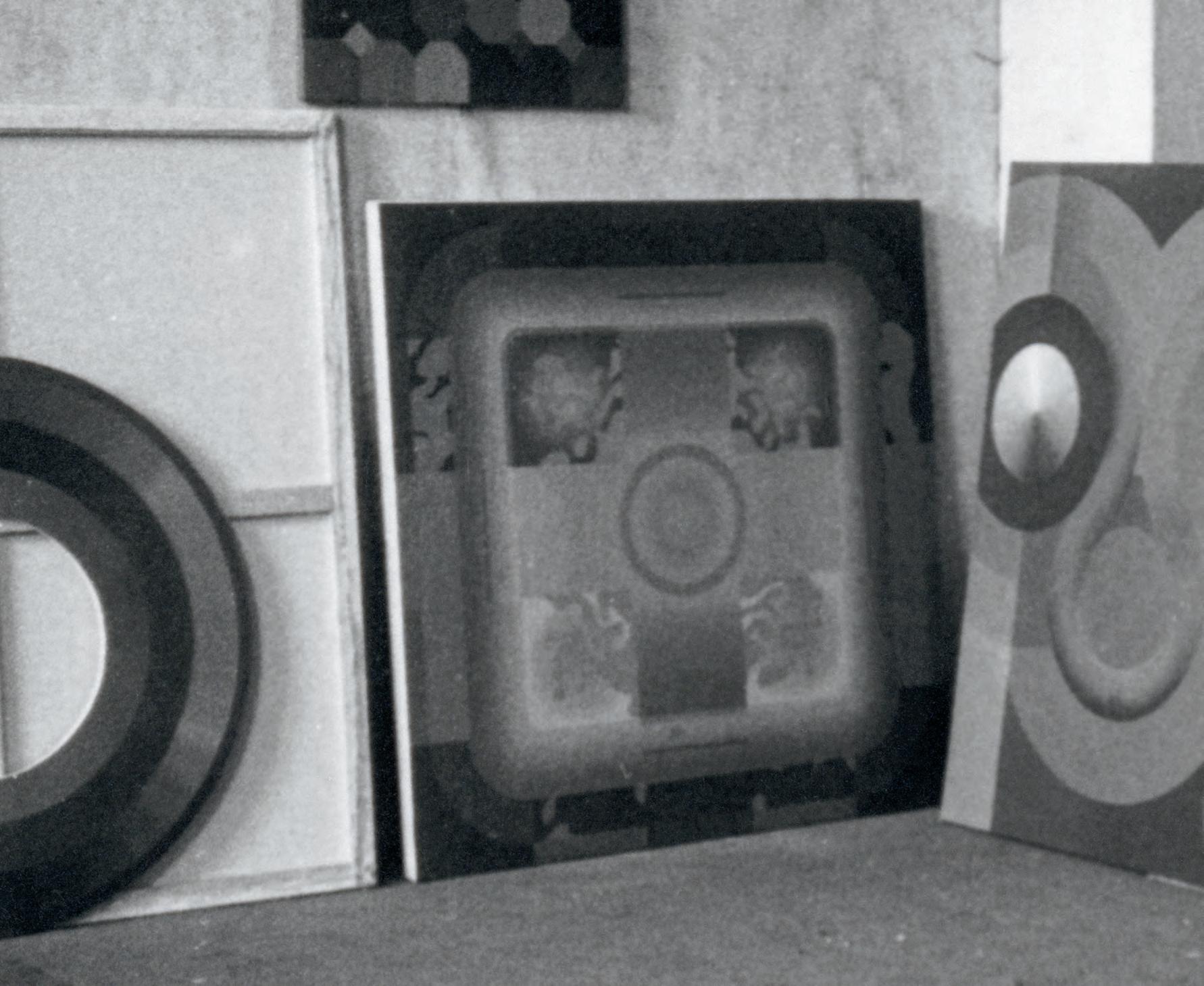
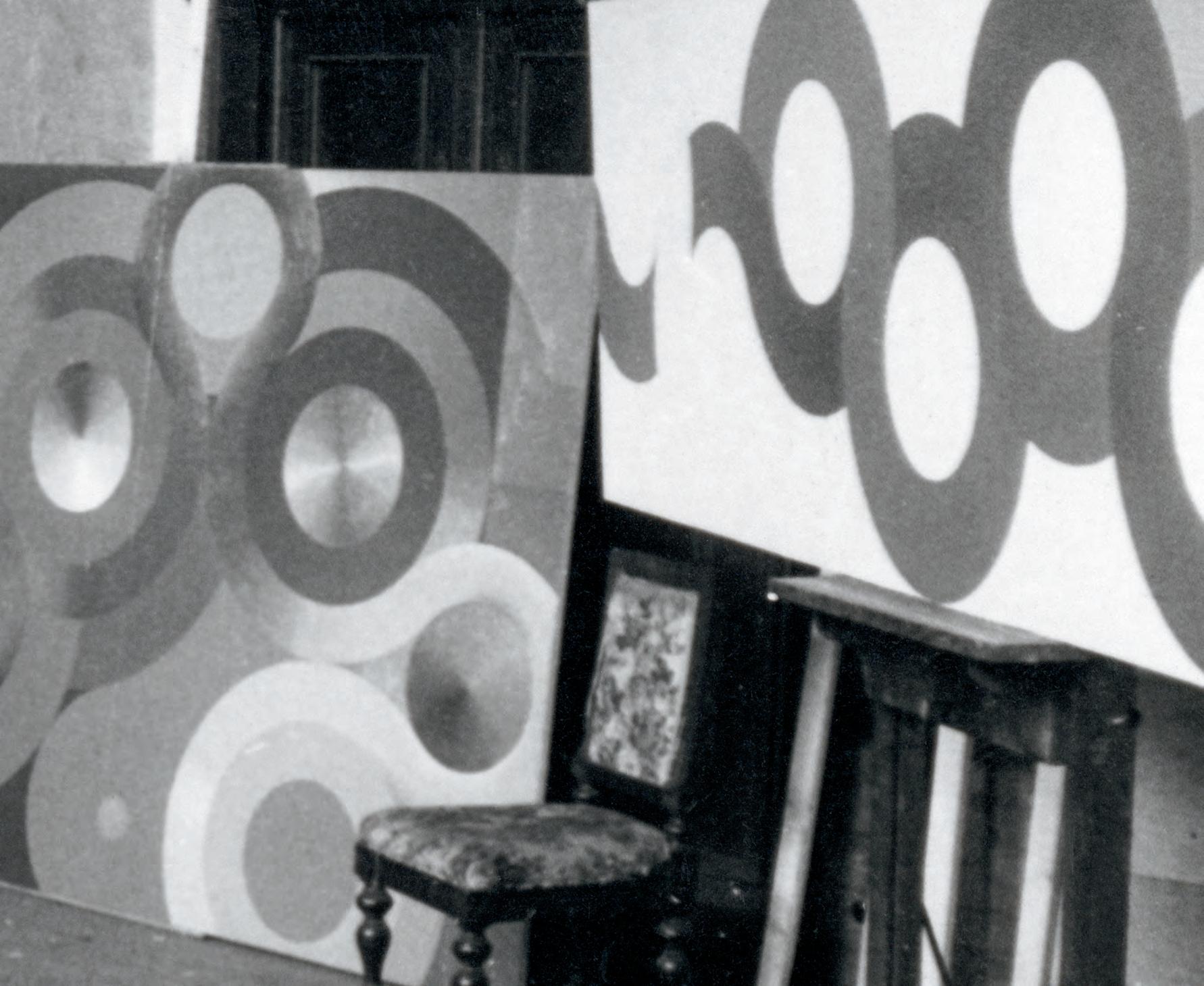
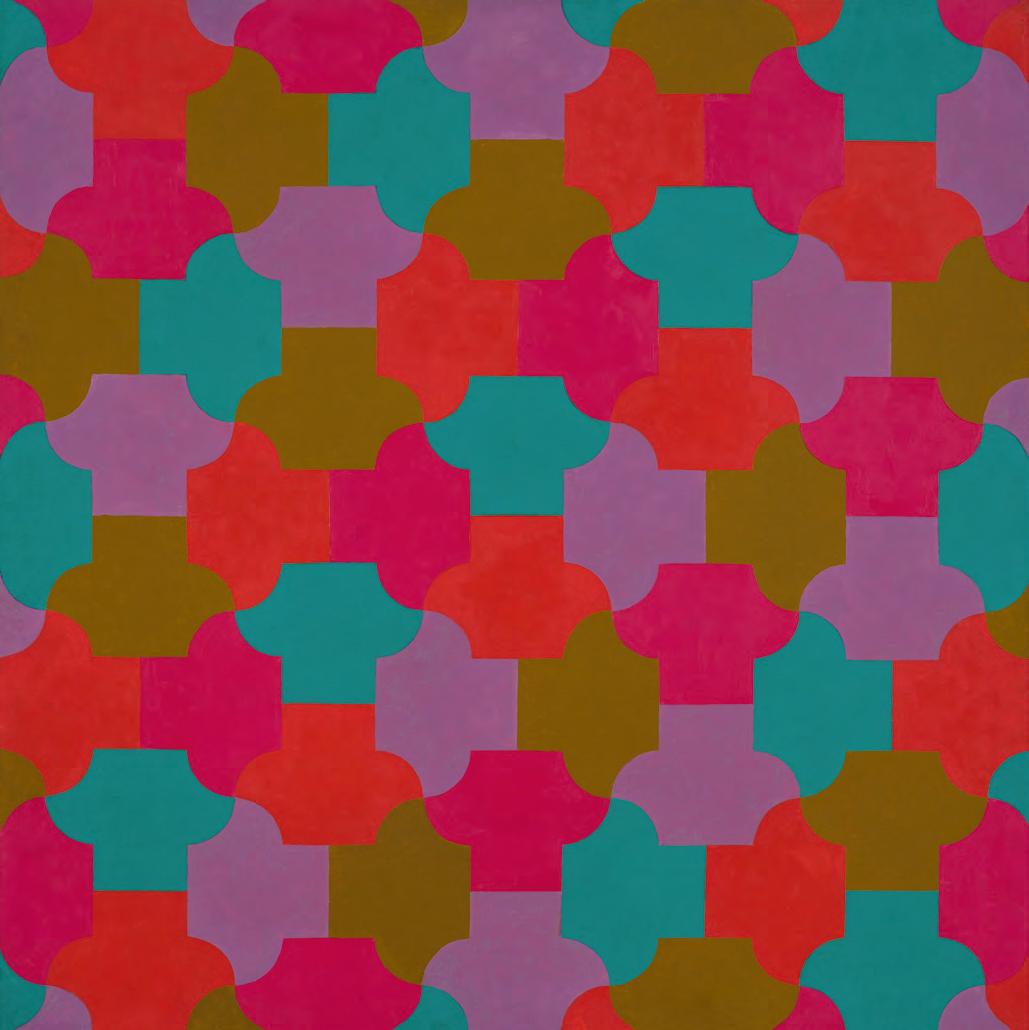
FIG 4: A Gentle Tessellation, 1966 / 6 8 Oil on canva s, 43 1⁄4 x 43 1⁄4 inches
THE MIND A S I T ME A S U R E S
George Woodma n ’ s Patterns
Rebecca Skafsgaard Lowery
In an undated set of notes for one of the many courses George Woodman taught during his four decades at the University of Colorado at Boulder, he cheerfully paraphrases Le Corbusier’s 1923 classic Toward an Architecture, writing, “Art is the joy of the mind as it measures!”1 This phrase encapsulates the intellectual thrill that underlay each phase of Woodman’s evolution as an artist whose long career spanned a profusion of modes of expression, all shaped by curiosity about the porous boundaries of form, space, and meaning.
Woodman’s art production of the 1960s and 70s, in particular, follows an intensely probative arc of experimentation, progression, and metamorphosis. From his initial embrace of pattern in the early 1960s, Woodman’s investigation and analysis of its possibilities compelled him to transcend the canvas to occupy three-dimensional space in multiple fashions. In this period, Woodman developed a singular body of work that is defined in not only aesthetic but also deeply structural terms, informed by mathematical principles and an internationally inflected language of ornament and design.
Past accounts of Woodman’s artistic pathway have described Cézanne-inspired landscapes in the 1950s giving way to vibrant abstractions and pattern paintings in the 1960s and 1970s, then to shaped figurative canvases and multiple-exposure black-and-white photography in the 1980s, the latter continuing to captivate the
artist for the rest of his life. The progression seems linear and logical in this telling, but omits elements that do not map so neatly onto the storyline: photography was always present in some form of the practice, for example, whether it was work in the darkroom or capturing objects and patterns of interest in his travels around the world. Woodman also created a number of installations of paper tiles positioned on and off the wall and translated this work into ceramic in a series of public art commissions. He painted freestanding screens and made sculpture that is still little known; at home, Woodman also turned furniture into brightly patterned art.
Cézanne would remain an important guide throughout; his “insistent search for clear realization of form,”2 particularly in his continual return to the apple with which he famously wished to astonish Paris, was a remarkable example for Woodman of what could come of extended attention to ideas. Lessons from Matisse, Léger, and Mondrian with their dynamic flat surfaces also appear in Woodman’s earliest pattern paintings, where he explored the notion in fragments bits and sections within larger compositions where looser brushwork contrasted with more hard-edged design (fig. 1). These and many other artists made regular appearances in his notes throughout the years as Woodman worked through pattern as it pertained to the history of art and craft, to his own work, and to nature and mathematics.
By the mid -1960s, pattern had become a dominant force for Woodman, often overtaking the whole of the canvas; although working in Boulder, in this he was certainly in dialogue with minimalist painters in New York such as Frank Stella, who had led the charge into post-painterly abstraction from the late 1950s, and Alfred Jensen, who began his investigations into numerically driven compositions around the same time. Ever a disciple of the aesthetic world and its place in the life of the mind, Woodman pored over works by these and other artists like Donald Judd, Jasper Johns, Sol LeWitt, Agnes Martin, and Richard Serra in the pages of art magazines and on visits to New York.3 These artists are constantly referenced in Woodman’s teaching and personal notes; LeWitt, in particular, was a kindred spirit in his intellectual rigor and sensitive approach to the simplest elements of square, line, cube, and color (fig. 2). Woodman particularly admired LeWitt’s modular sculptures, which he described as “lattice decorative element [s] taken seriously as content ”4
This notion of taking the decorative form seriously as content, whether in two or three dimensions, found expression in Woodman’s experiments with periodic tessellation or tiling patterns that, when extended across a plane, repeat regularly in all directions without overlaps or gaps. This is in the case of San Francisco di Paolo or Axe Pattern (1966; p. 27), which uses a single form rotating 90 degrees at a time to comprise its entire surface. In later writing, Woodman argued that these infinitely extendable arrangements “suppress figure-ground relationships thus emphasizing part to part continuity in favor of part to whole relationships. In this democracy of parts, ‘composition’ is sidestepped since the elements have no hierarchical relationship to each other.”5
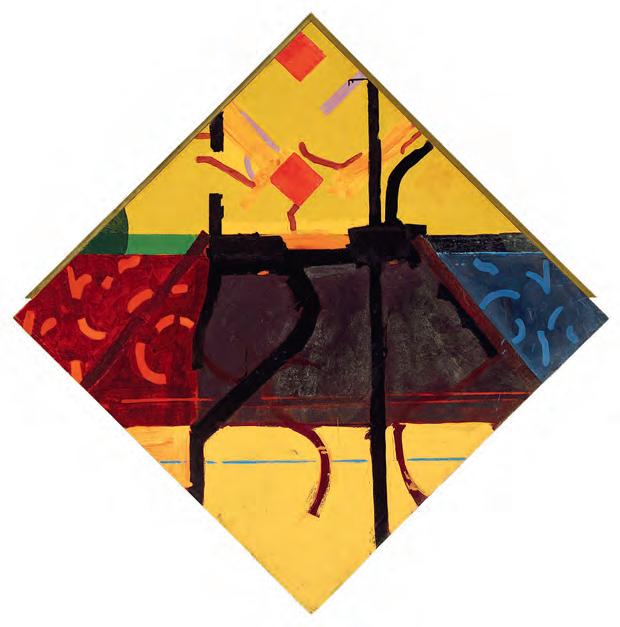
The vision of theoretically boundless extension had been enormously enriched by what he and wife Betty Woodman encountered on their many international travels. From their honeymoon visit to Mexico in 1953 to their transformative yearlong trip to Italy in 1959, 6 then further travels to countries such as Spain, Morocco, Greece, Croatia, and Turkey, the Woodmans together amassed a considerable mental and photographic encyclopedia of global styles of architecture and decorative ornamentation. A 1965 visit to the Alhambra in Granada, Spain, in particular, had a major impact on George’s own pattern sensibilities. This famed Islamic palace, a pinnacle of architectural and artistic synthesis where geometry, ornamentation, and spatial harmony converge, impressed on him that a myriad of patterns and motifs could indeed harmonize and create an opulent yet visually balanced environment.
FIG 1: George Woodman, Cleopatra (With Asp), c 1963 Oil on canvas, 48 x 51 inches
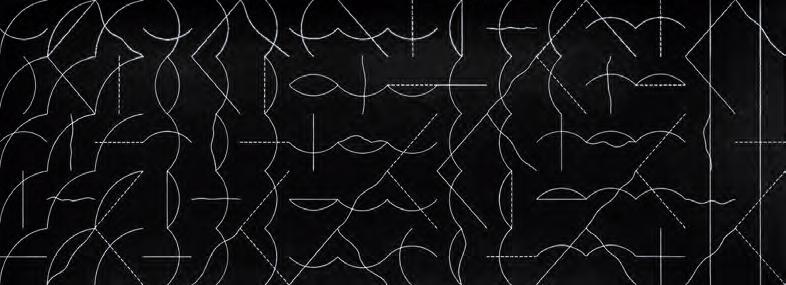
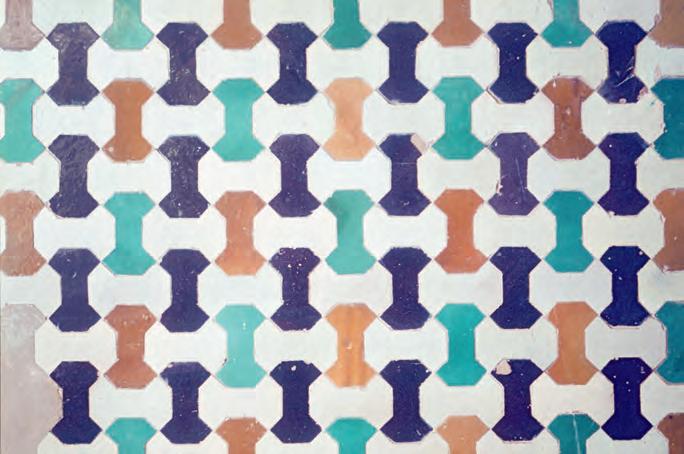
Woodman’s synthesis of the lessons of the Alhambra is evident throughout the pattern paintings, but is in its clearest focus directly following his initial encounter. One of the many photographs taken of the complex’s tile patterns while on his visit formed the inspirational basis of a number of paintings he would make in the years immediately ahead (fig. 3). In A Gentle Tessellation (1966 / 68, fig. 4, pg. 4), for example, Woodman both replicates and transforms this pattern with great sensitivity and attention to its compositional logic. The tiles in the Alhambra design are arranged in a regular horizontal (white tiles) and vertical (four other colors of tile) pattern. Woodman adopts the arrangement as-is, but upends the logic of color. While the painting maintains the Alhambra’s five-color scheme, the artist adjusts the tiles slightly, adding soft curves to certain facets. These bowtie-like lozenges are all bisected with interlocking combinations of lilac, teal, brown, fuchsia, and coral, creating what could either be considered a new pattern using halflozenges or the same pattern with a new internal color scheme.7
Using templates of his own design, Woodman began in this era to revisit shapes across multiple works, exploring their combinatory possibilities. This iterative process reflected his fascination with the mathematical principles underlying pattern and its capacity to suggest both order and endless variation. Each painting became a unique investigation into the interplay of form, color, and spatial perception. Across the course of the 1960s and 70s, even when Woodman’s patterns were fully periodic (meaning their component shapes repeated regularly across the work’s surface), color rendered them dynamic, evoking movement and spatial complexity; through color, he could create optical depth and a sense of undulation, con-
FIG 2: Sol LeWitt Wall Drawing #260 , On Black Walls, All Two-Part Combinations of White Arcs from Corners and Sides, and White Straight, Not-Straight, and Broken Lines , 1975. Crayon on painted wall, Dimensions variable. Museum of Modern Art, NY. Gift of an anonymous donor. © 2025 The LeWitt Estate / Artists Rights Society (ARS), New York
FIG. 3: Tile pattern at the Alhambra, Granada, Spain, photographed by George Woodman for stud y, 1965
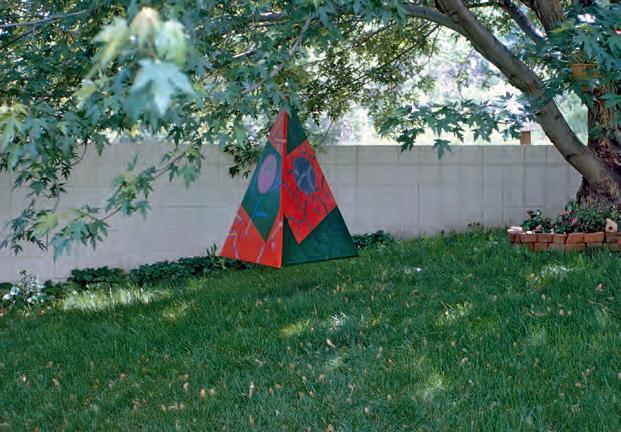
cavity, or convexity. In 1978, Woodman wrote, “[Tessellated] patterns have been an invitation to give color a prominent role as a formal element. When structurally the painting is an homogeneous extension of small parts, the control and guidance of attention, the scaling of contrasts, spatial articulation and the development of specific shape identities are all powers granted to the inflection of color.”8
By this point, he was using color to more “idiosyncratic and romantic”9 ends, in his own words. In Grey Portal (1978; p. 45), bolder colors are grouped in the painting’s center, diffusing outward as progressively lighter pastels and greys. The concentration of color in the center is a variation on an effect he used in numerous other pattern paintings of this period, deploying chromatic softening
around the perimeter to suggest an internal frame. As its title suggests, here the gradient plays more on the notion of a passageway.
Woodman’s tessellating forms in Grey Portal are intriguingly eccen tric, their mix of straight and irregularly undulating facets resembling something like a map. The complexity of the arrangement is astounding: more than 50 different tile shapes make up its mysteriously undulating surface, some of which are seen only once or twice.10 As avowed by Woodman, this is an aperiodic tiling, defined in mathematics as a set of shapes that can tile a plane without ever repeating. Woodman’s understanding of pattern as mathematic specifically, geometric and therefore intrinsically tied to dimensional space underpinned all of his work in pattern.
In an unpublished manuscript titled Pattern: The Intellectual Side , he argued, “The intellectual challenge of pattern stems from two sources, one is the neurological gift to comprehensively see and invent these forms. The other is the fact that pattern is about space, its structures follow the laws of geometry.”11 Euclidean geometry was a touchstone for Woodman throughout his life; the touching intimacy with which it resonated with him is evinced in an undated Valentine’s Day composition for Betty, likely written in the early 2000 s, which reads in part, “The invention of God seems a questionable benefit in our present world. But still it is nice to have someone to receive our gratitude. Thank God for the parallelogram, thanks for Euclid.” 12
A pivotal if unusual work from the earlier pattern period is Pattern on Trapezoid (1967, p. 29), a painting with an uncanny, almost
FIG .5: George Woodman, Untitled , c 1964. Pyramid-shaped painting suspended from a tree in Woodman’s back yard, Boulder, Colorado
trompe l’oeil effect that gives the impression of a pattern nearly leaping off the wall, stretching as it attempts to transition to the floor. This work once again employs shapes inspired by Alhambra tiles here rendered as irregular polygons with curves eliminated while evoking the intricate inlaid Italian floors he took inspiration from for Cosmati (1966, p. 17),13 gesturing to dimensional form across three axes even as it is mapped by the traditional two of painting. Pattern on Trapezoid can be understood in one sense as a fulcrum between Woodman’s two- and three-dimensional explorations, pointing to a kind of continuity between his painting and the later architectural interventions. Woodman’s interest in and impulse toward three-dimensional form can be seen as early as 1964, when he installed and photographed a (now presumably lost) pyramidal painting in the family’s Boulder backyard (fig. 5).
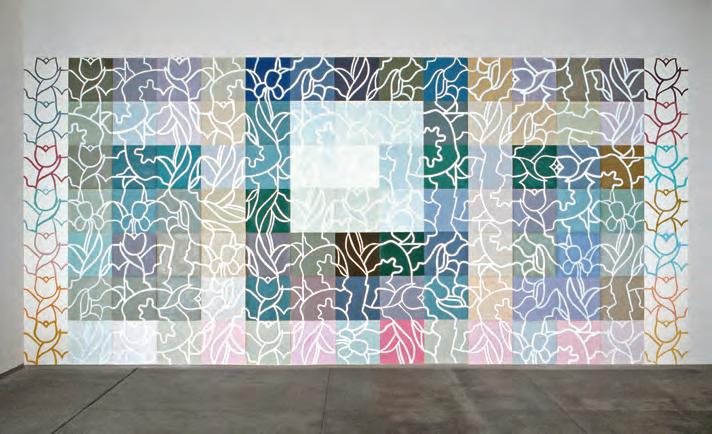
The notion of geometry as a spatial discipline is attested to in a set of undated schematics Woodman seems to have used to figure some of its particulars out for himself. In one of these photographs, he has annotated three wooden dice, subdividing each side of the cubes into numbered quadrants (fig. 6). On each die, three sides are identified with plain numerals, whereas the numbers on the other three sides are circled. In the photograph, the dice are arranged in a row,
first showing only the circled numbers, then the plain numbers, and finally a combination of the two, under which he reminds himself,
“Note mirror reflection.” A photocopy of an original sketch further elucidates the goal of the exercise: here, Woodman draws the die as if it is transparent, labeling all six sides at once (fig. 7). He writes, “Rotation on diagonal axis connecting 2 opposite corners. 3 surfaces about one corner are mirror images of 3 surfaces about other corner.” In order for any plain side to match the numerical arrangement of its corresponding circled side, it would need to rotate through space, 90 degrees around one axis and another 90 degrees around a perpendicular vector. In a sense, Woodman is working out what it looks like for flat shapes to tumble through dimensional space.
The series of paper tile installations that Woodman would begin producing in the late 1970s brought his patterns into deeper dialogue with their surrounding environments and eventually onto the floor itself (fig s. 8 & 11, pg.13). On the way to this more spatial application of his two-dimensional patterns, though, he created a significant body of work in sculpture, including faceted columns and spheres. These sculptures, which he likely made in the mid1970s, brought his abstract forms to life, transforming patterns
FIG 8: George Woodman, paper tile installation, Sentimental Geometry , on view in Criss-Cross at Yellowstone , Yellowstone Art Center, Billings, Montana, 1981
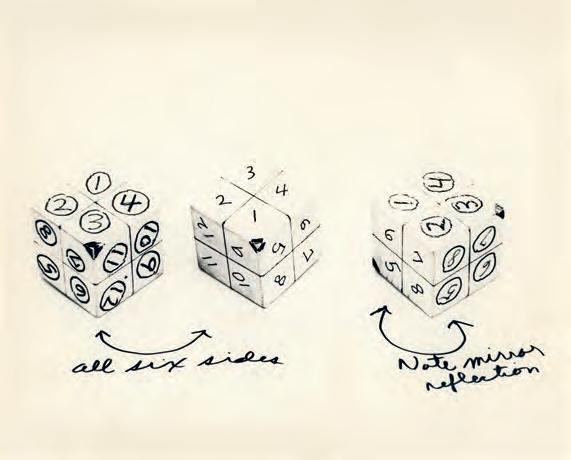
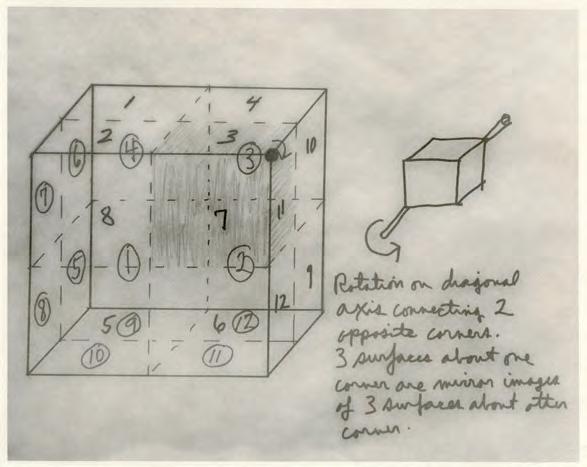
into dynamic, spatial entities; although they do not seem to have been exhibited in Woodman’s lifetime, he photographed them extensively, arranging individual works in differing configurations that revealed the variety of their faces and vertices (figs 9 & 10)
Like the pyramidal painting, these works can be seen as a bridge between Woodman’s two-dimensional paintings and his architecturally inspired installations and public art projects. They reveal an artist deeply engaged with the possibilities of form and space, experimenting with the ways in which patterns are able to both occupy and transform physical environments. The faceted columns and spheres suggest a further motion toward modularity and adaptability, qualities that would later define his public art projects.
A comparison of these polyhedral sculptures with Untitled (1975, p. 33) reveals the degree to which Woodman was using pattern and color to think in three dimensions.
The emergence of Woodman’s paper tile projects in the late 1970s marked a significant evolution in his exploration of the possibilities of pattern. He understood these projects as both an evolution of his composition technique for painting as well as a precursor to his later ceramic tile installations, writing in 1982, “The patterning of surfaces with paper ‘tiles’ first began as a form of preparatory ‘drawing’ for paintings. It then developed both as an approach to situational art and as research into a new systems base for proposals in ‘real’ ceramic tile ”14
Initially wall-based, the paper tile installations eventually expanded to encompass folding screens and floor-based design, further blur-
FIG . 6: George Woodman, photographed sketch and notes, undated
FIG 7: George Woodman, photographed sketch and notes, undated
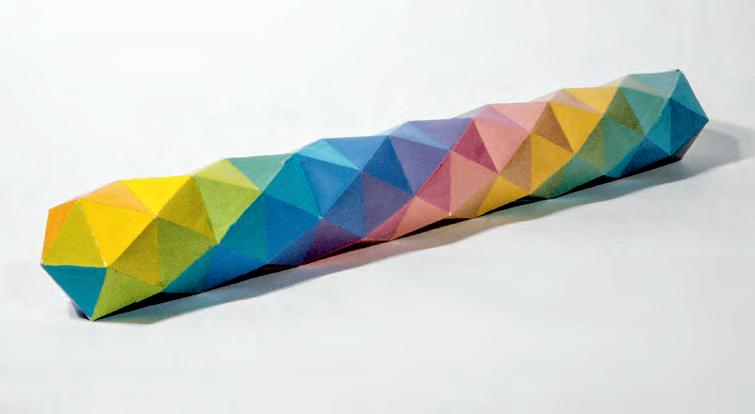
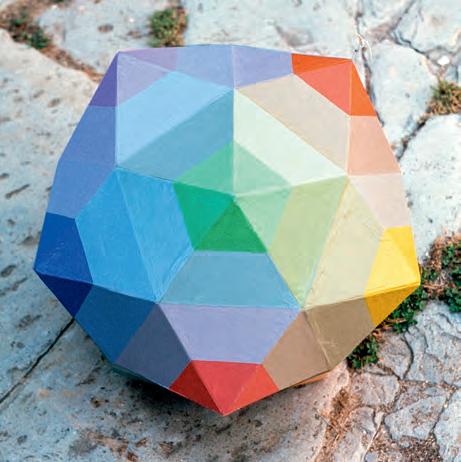
ring traditional distinctions between painting and sculpture and underscoring the adaptability of pattern as a medium. In this sense, these projects anticipate contemporary discussions about the role of art in public spaces and its potential to foster community and connection. Notably, students were invited to collaborate with Woodman on several projects, hand-painting paper tiles following his designs at Wright State University (1981), Viterbo College (1982), Alfred University (1983), and the Rochester Institute of Technology (RI T, 1984). At Alfred, the tiles were applied to drywall panels that zigzagged across the gallery floor like folding screens. RIT was where the tiles reached the floor in a magnificent arrangement that reads like a lexicon of Woodman’s decorative influences and experiments in pattern, recalling equally the early lessons of the Alhambra and the instruction-based wall drawings of LeWitt ( fig. 11, pg. 13).
Somewhere amid his abundant volumes of archived class notes, Woodman references one of John Donne’s Holy Sonnets, which begins: “At the round earth’s imagin’d corners, blow / Your trumpets, angels, and arise, arise.” For Woodman, these lines illustrated Donne’s attempted reconciliation of scientific understanding with historical visual interpretations of the Last Judgment (fig. 12).
Unidirectional pathways to any purported Heaven and Hell are incongruous with a round Earth set in a universe where there is no fixed “ up ” or “down;” it may instead make sense to picture multiple axes and directions. Rotated into another position, this could be seen as a metaphor for Woodman’s own understanding of pattern as a means to approach the visible and imperceptible complexities of a multidimensional world.
FIG . 9: George Woodman, 5 Sided Column , c. 1973
FIG 10: George Woodman, Untitled , c 1974
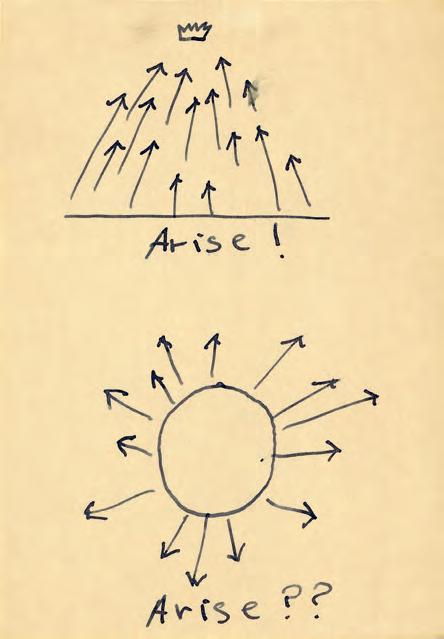
Rebecca Skafsgaard Lowery is Curator of Exhibitions at the Wexner Center for the Arts at The Ohio State University. She was previously an Associate Curator at The Museum of Contemporary Art, Los Angeles, where she organized and co-organized numerous exhibitions including Olafur Eliasson: OPEN (2024), Josh Kline: Climate Change (2024), Simone Forti (2023), and Tala Madani: Biscuits (2022–23). Rebecca has also held positions at the Museum of Modern Art, the Metropolitan Museum of Art, and the Grey Art Gallery. She holds a PhD from the Institute of Fine Arts at New York University.
NOTES
1 George Woodman, teaching notes, undated. George Woodman Collection, Woodman Family Foundation Archives, New York.
2 George Woodman, “Gulliver in the Garden,” Village Voice (New York), Nov 4, 1986.
3 It is perhaps worth noting that these reproductions would have been largely in black and white at the time; Woodman’s extraordinary range of palettes contains a vast array of references but is wholly of his own invention, which surely contributes to the surprise and freshness it holds today.
4 George Woodman, teaching notes, undated. George Woodman Collection, Woodman Family Foundation Archives, New York. In Boulder, Woodman would also later become an associate of the Criss-Cross artists’ cooperative, established in 1974 by a group of his former students, including Clark Richert, Charles DiJulio, and Richard Kallweit. The collective was launched with a particular focus on pattern and structure and established an avant-garde periodical, Criss-Cross Art Communications (CCAC), to which Woodman was a frequent contributor and which expanded the discourse of pattern painting among artists across the country.
5 George Woodman, “Statement,” Criss-Cross Art Communications no 6 Mar 1978): 4.
6 The Woodmans made a second yearlong trip to Italy in 1965 and by 1968 had purchased a farmhouse in Antella, just outside of Florence, which served as a residence, studio, and refuge for the whole family.
7 It is a testament to how difficult Woodman’s paintings are to reproduce that with no fewer than five printed and digital iterations to consult, I must still concede an iffiness in my naming of colors,
though their number is now certain. In an earlier discussion of this work, I was only able to discern four colors in the arrangement. See “Infinite Progress: Criss-Cross and the Gender of Pattern Painting,” in With Pleasure: Pattern and Decoration in American Art, 1972 –1985, ed. Anna Katz, New Haven, Yale University Press/Museum of Contemporary Art, Los Angeles 2019, pp. 10 4 – 121
8 Woodman, “Statement ”
9 Ibid.
10 In an earlier discussion of this painting, which I had only seen in reproduction, I was unable to discern the considerable sophistication and complexity of Woodman’s tessellation system in this painting, misunderstanding it to be comprised nearly wholly of discrete tiles. Extended in-person analysis followed by rigorous review of digital reproductions has made its extraordinary architecture more visible. See “Infinite Progress: CrissCross and the Gender of Pattern Painting,” op. cit.
11 George Woodman, Pattern: The Intellectual Side, unpublished manuscript, c. 1979. George Woodman Collection, Woodman Family Foundation Archives, New York.
12 George Woodman, note to Betty Woodman, undated. George Woodman Collection, Woodman Family Foundation Archives, New York.
13 The Cosmati were a group of medieval Italian artisans known for their richly detailed geometric floor mosaics, particularly in Roman churches. Woodman knew these inlaid floors intimately from his extensive time in Italy
14 George Woodman, Artist’s Statement, Haber Theodore Gallery, New York, 1982. George Woodman Collection, Woodman Family Foundation Archives, New York.
FIG 11: George Woodman, Rochester Carpet , 1984 Hand-painted chipboard tile installation. Bevier Gallery, Rochester Institute of Technology, Rochester, New York
FIG 12: George Woodman, sketch, undated
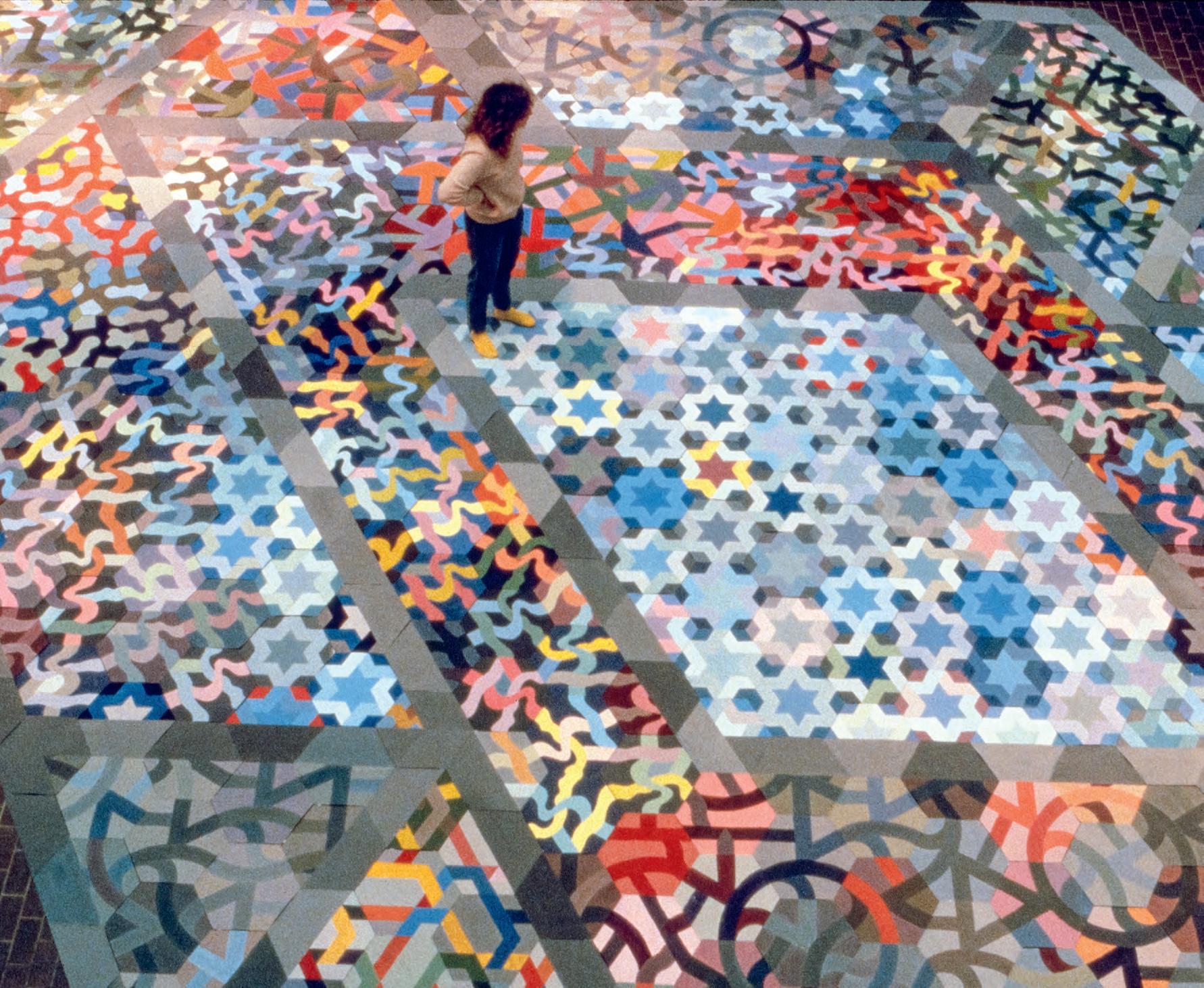
Piazza San Francesco di Paola, 1966. Oil on canvas, 31 5⁄ 8 x 31 5 8 inches
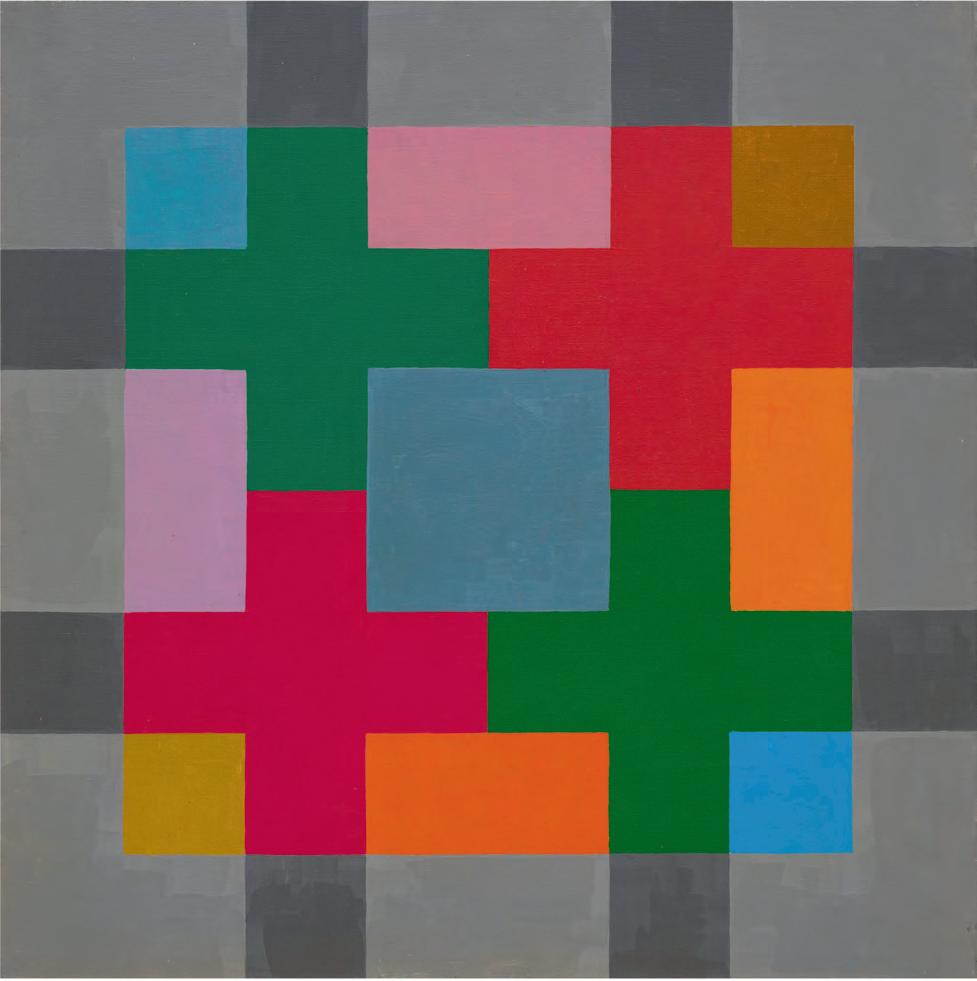
Cosmati, 1966. Oil on canvas , 5 9 1⁄4 x 5 9 1⁄4 inches
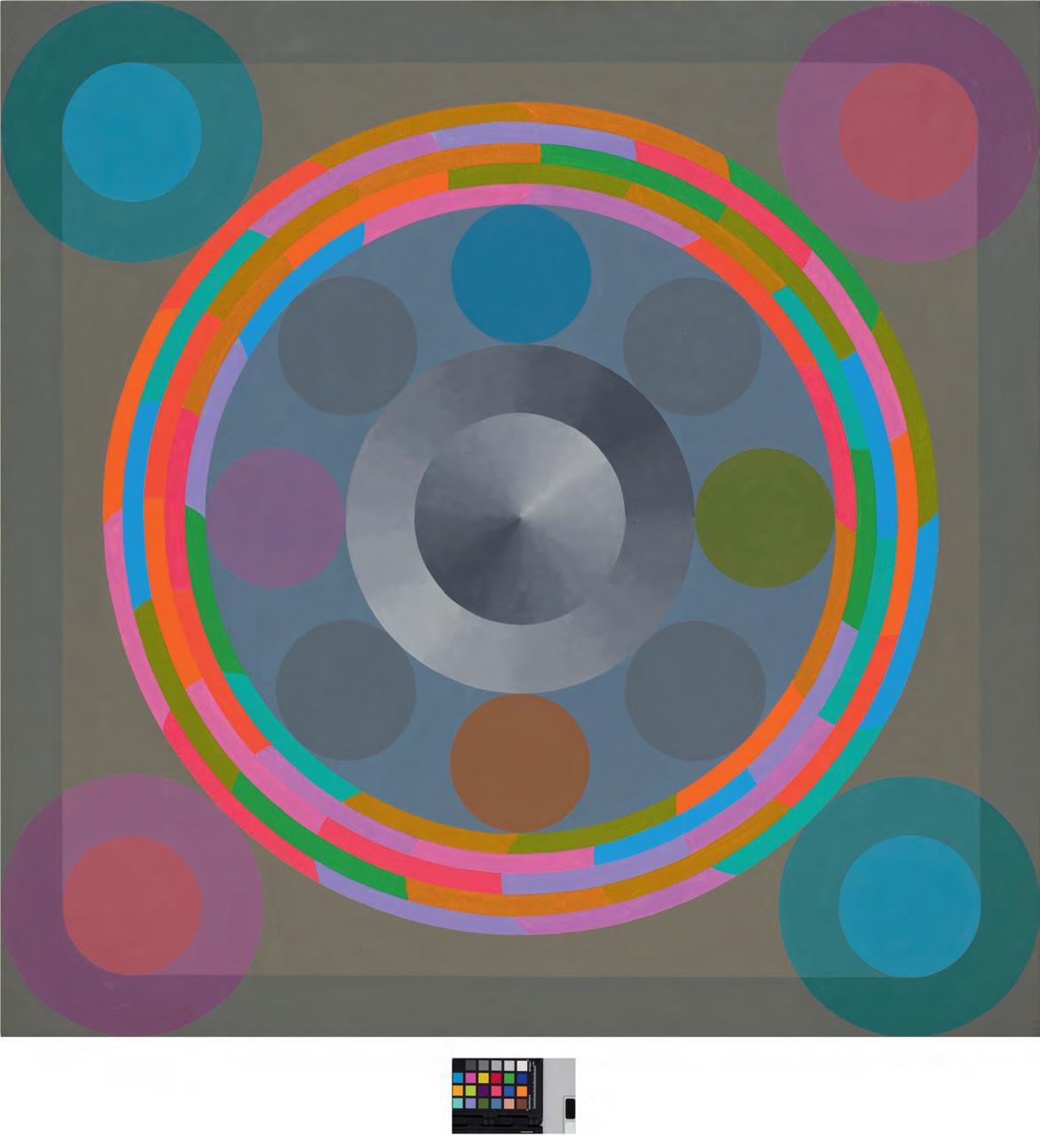
Untitled, 1966 . Oil on canvas , 66 3 ⁄ 4 x 66 3 ⁄ 4 inches
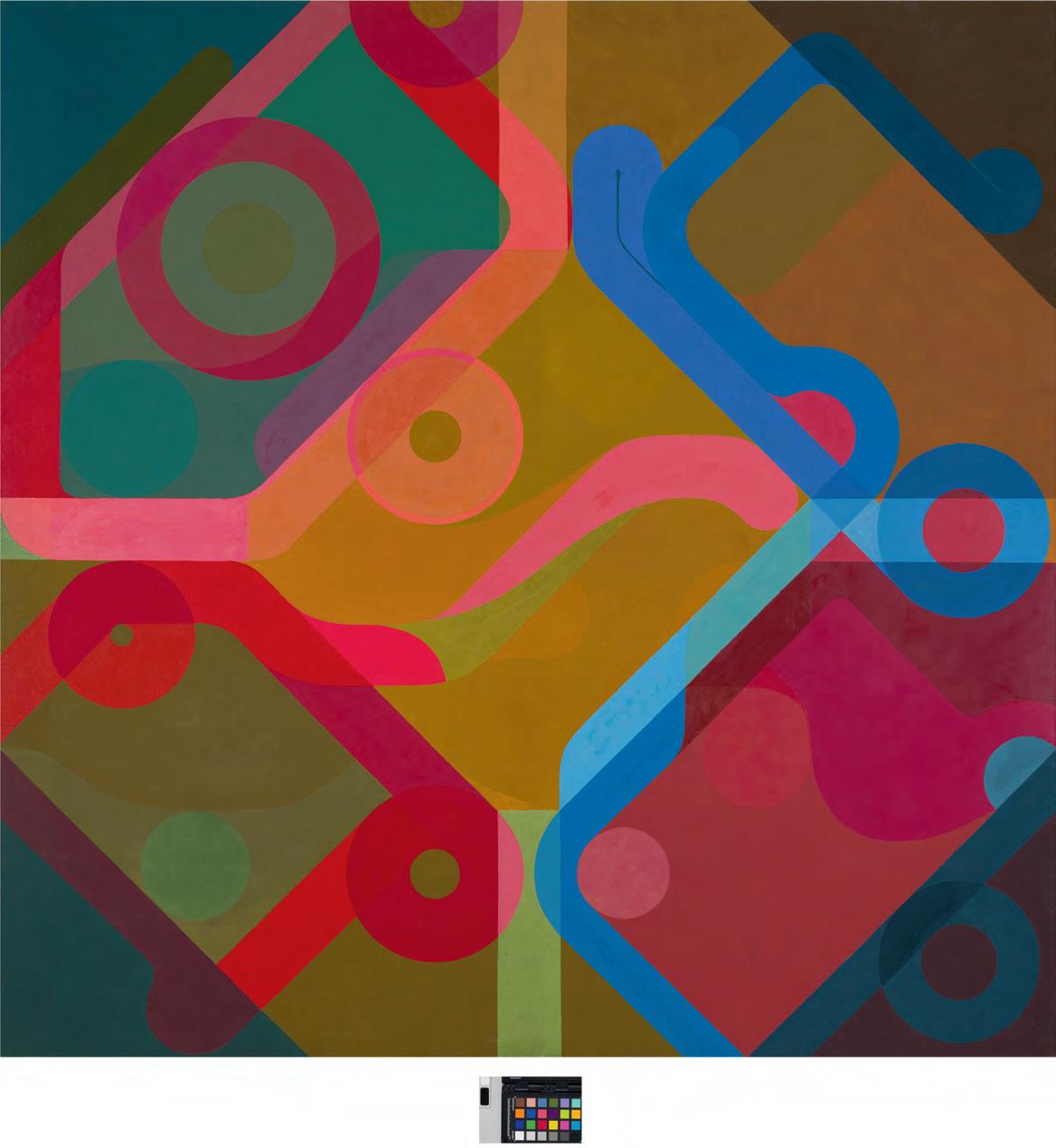
Untitled, c. 1966 . Oil on canvas , 8 3 1⁄4 x 83 inches
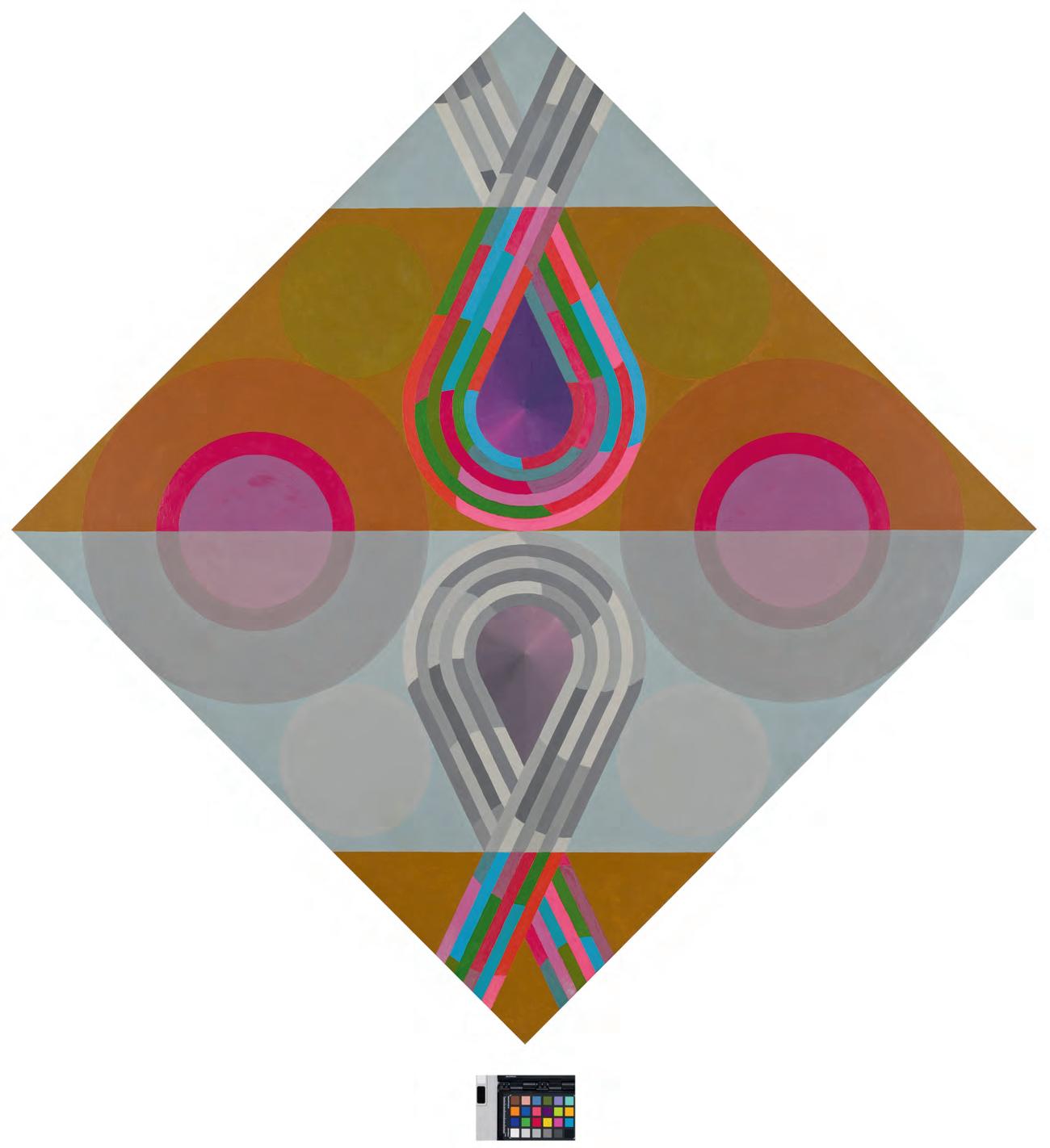
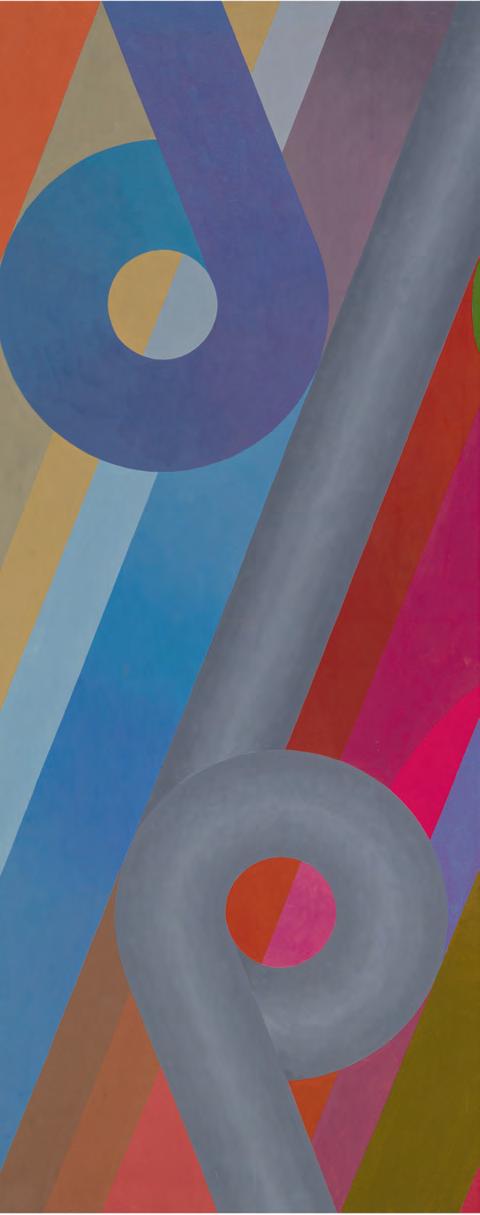
Untitled, 196 8. Acrylic on canvas , 63 x 9 8 1⁄4 inches
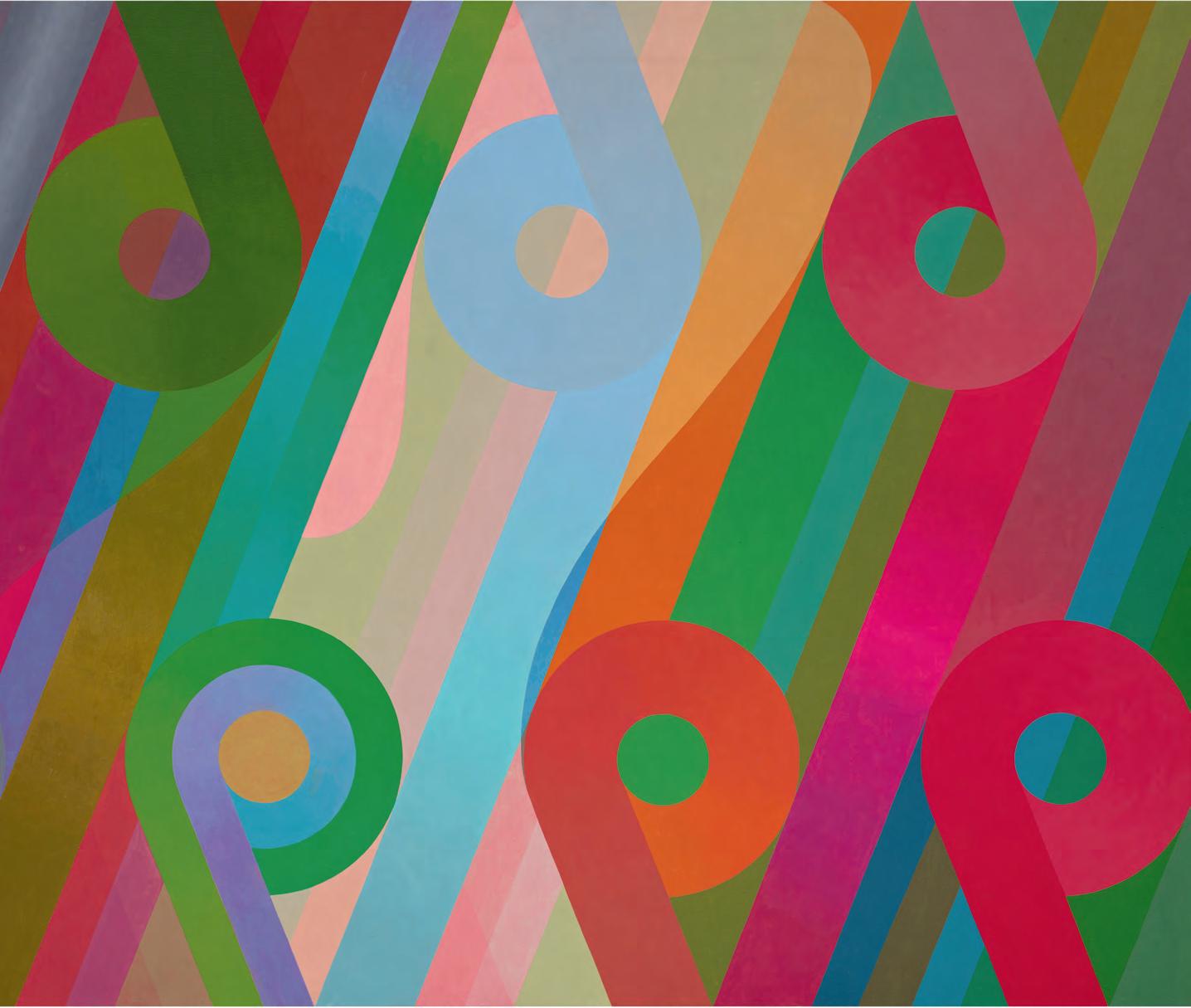
7 Colors in 4’s, 1966 . Acrylic on canvas , 67 x 67 inches
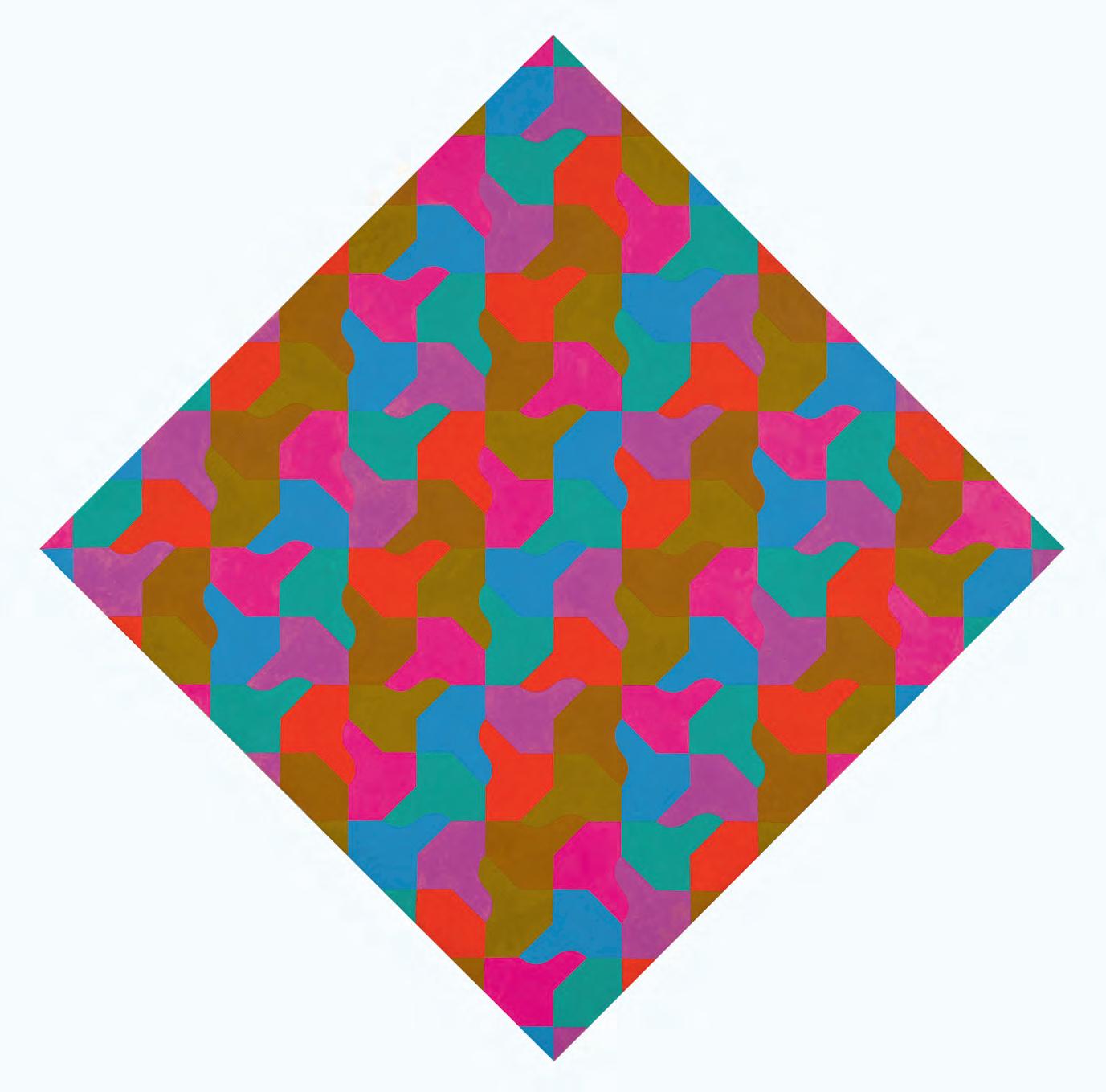
San Francisco di Paolo or Axe Pattern, 1966 . Acrylic on canvas ,
inches
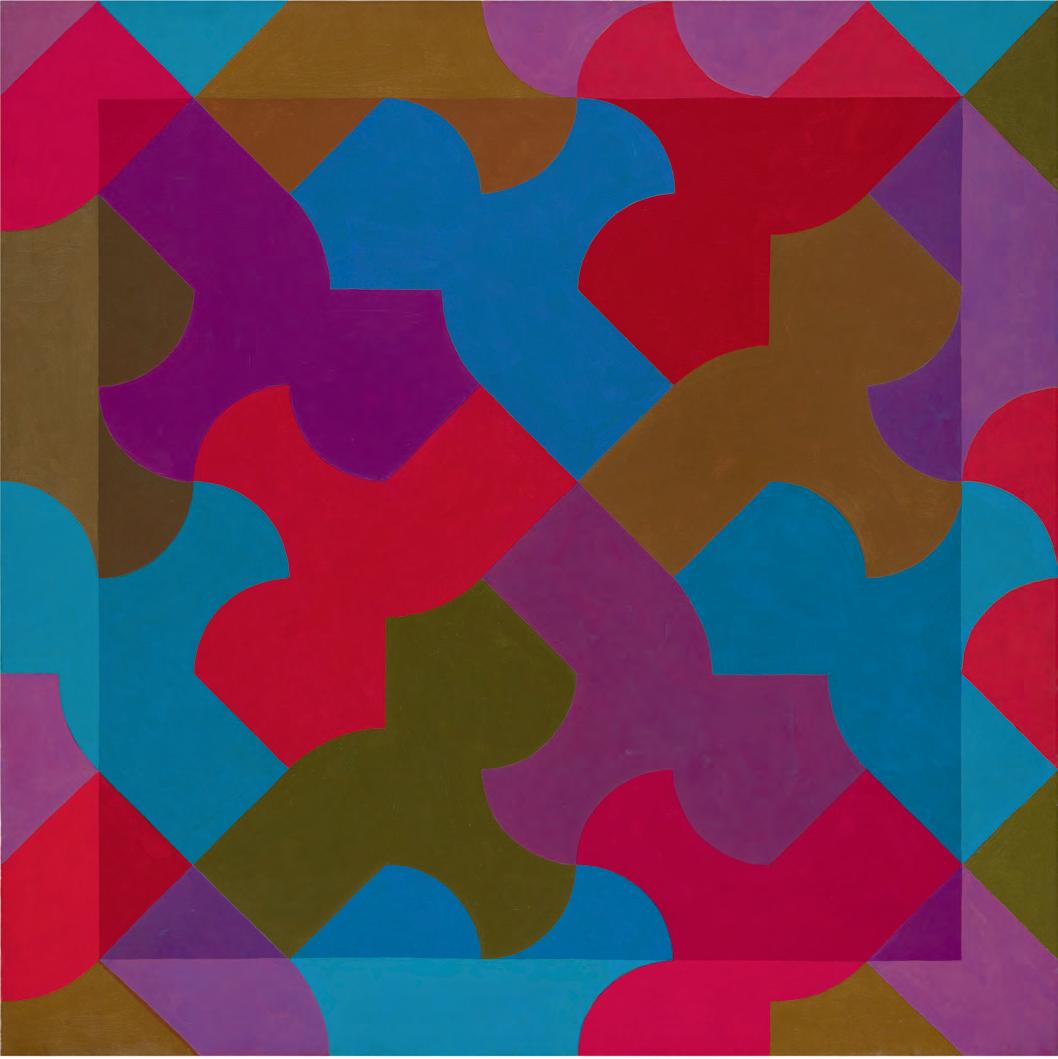
Pattern on Trapezoid, 196 7. Acrylic on canvas , 41 1 4 x 6 4 inches
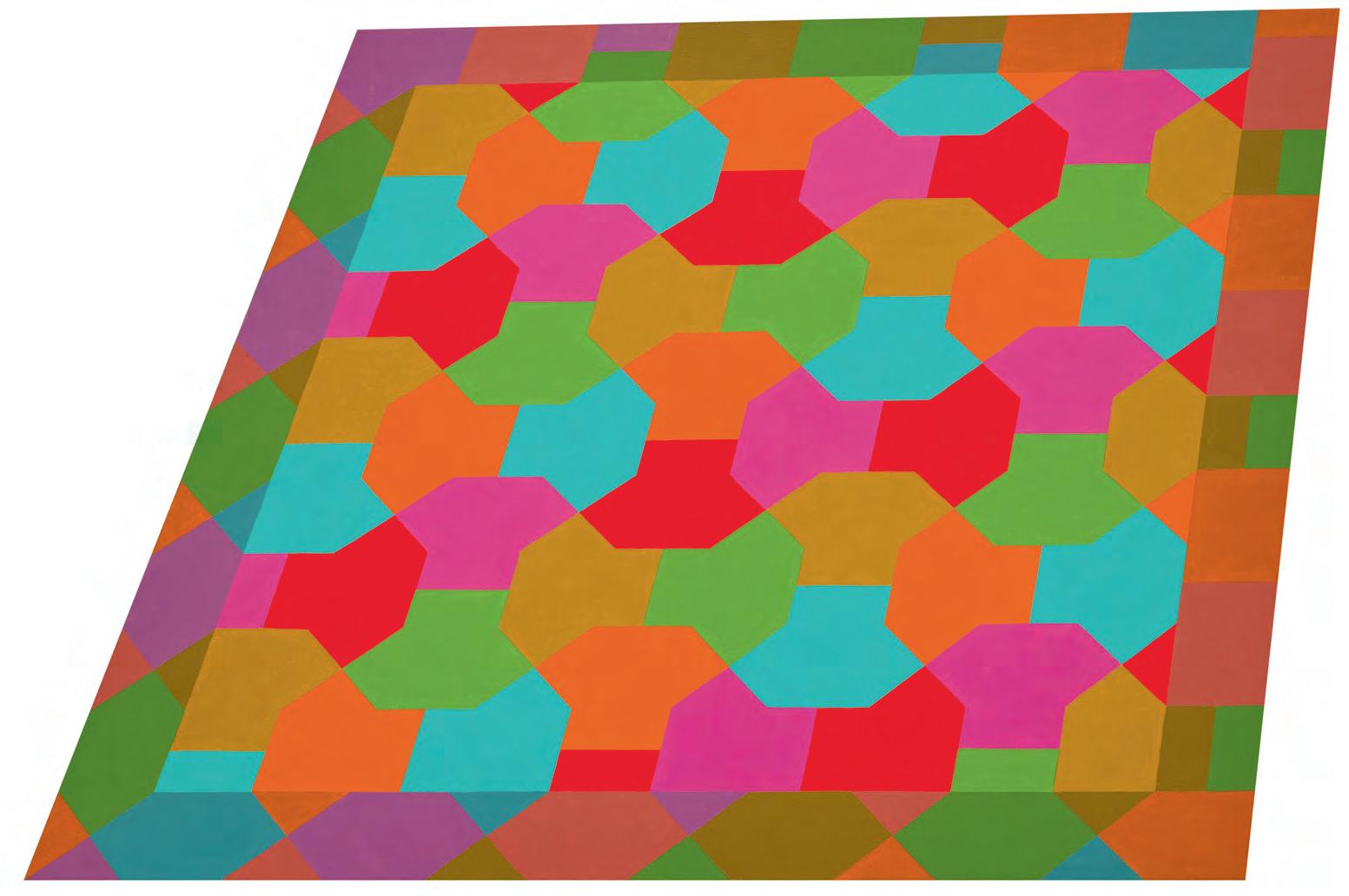
Untitled, 196 9. Acrylic on canvas , 4 8 1⁄4 x 4 8 1 4 inches
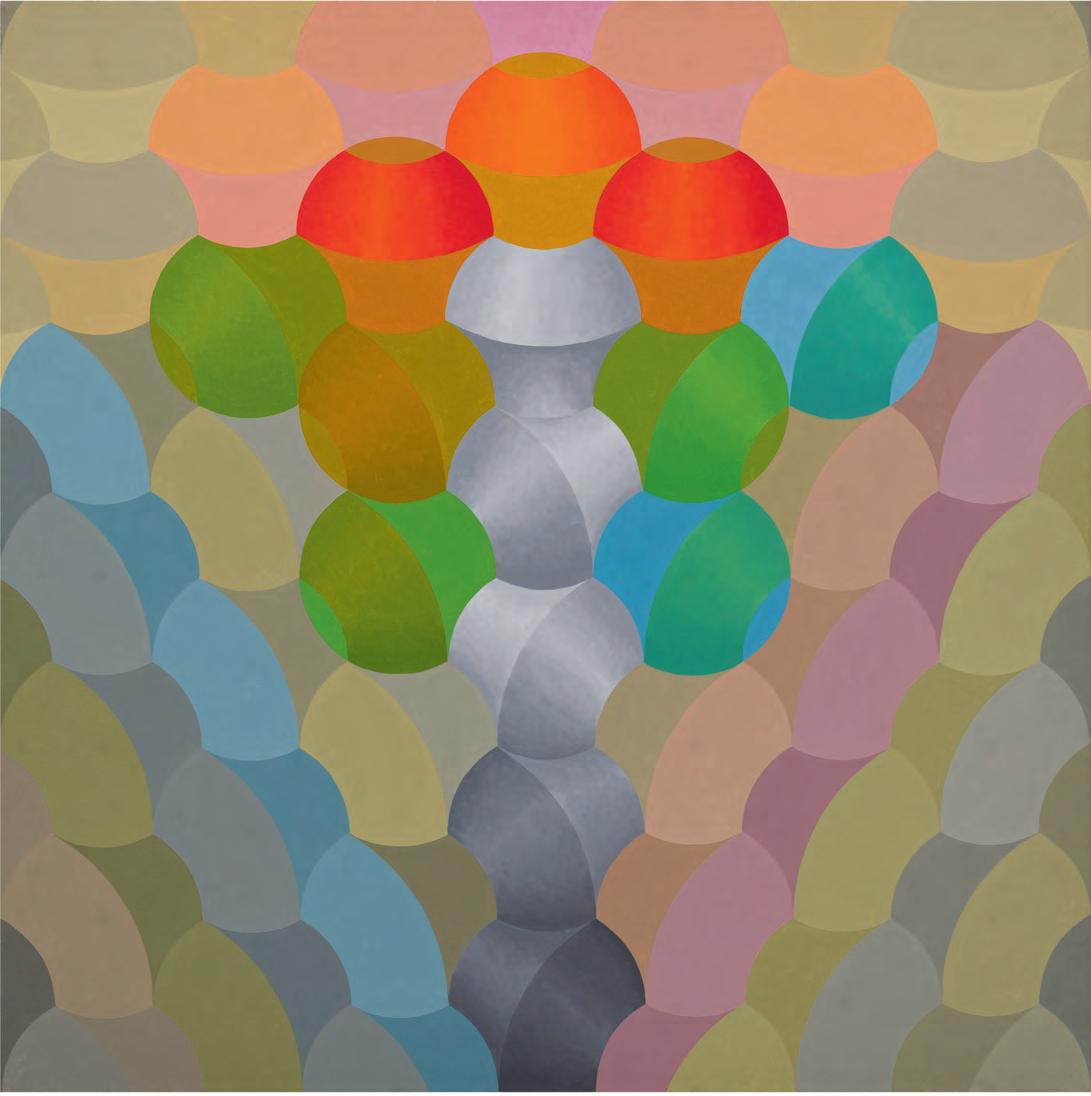
Untitled, 1975. Acrylic on canvas , 60 x 60 inches
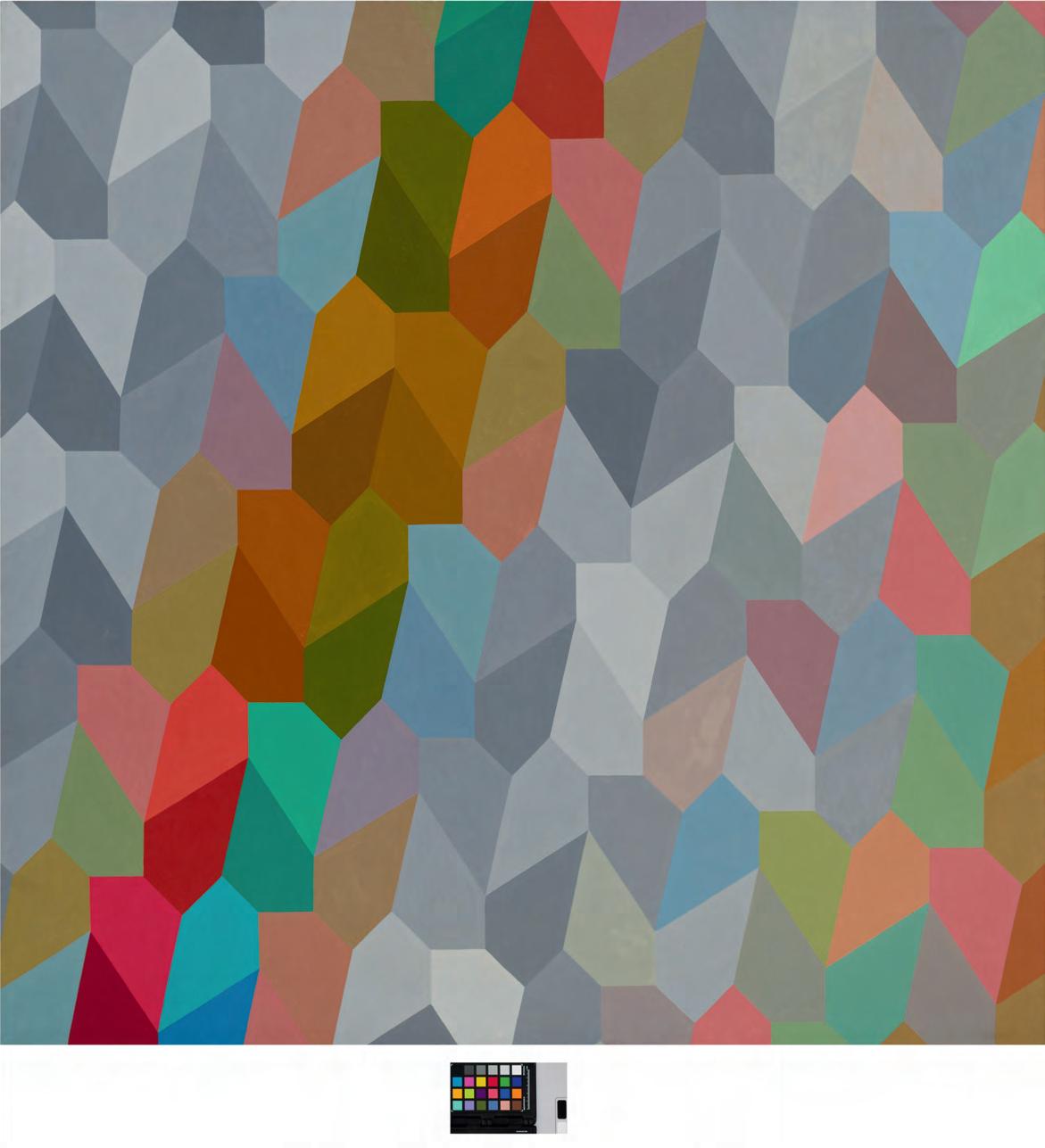
Untitled, c 19 70 – 71 Acrylic on canvas , 6 6 3 ⁄ 8 x 6 6 3 8 inches
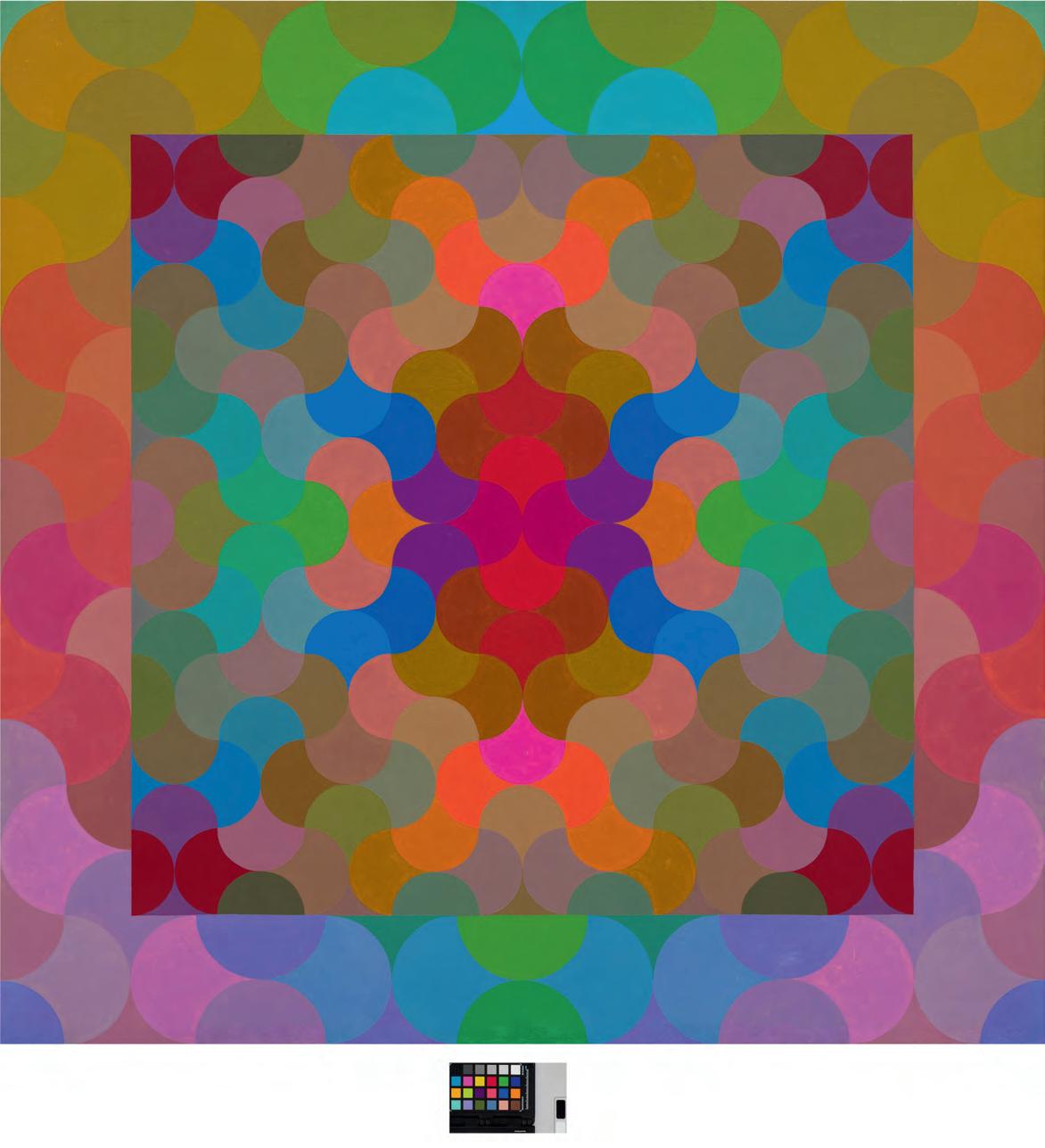
Untitled, c. 1971. Acrylic on canvas , 5 2 1 4 x 5 2 1 4 inches
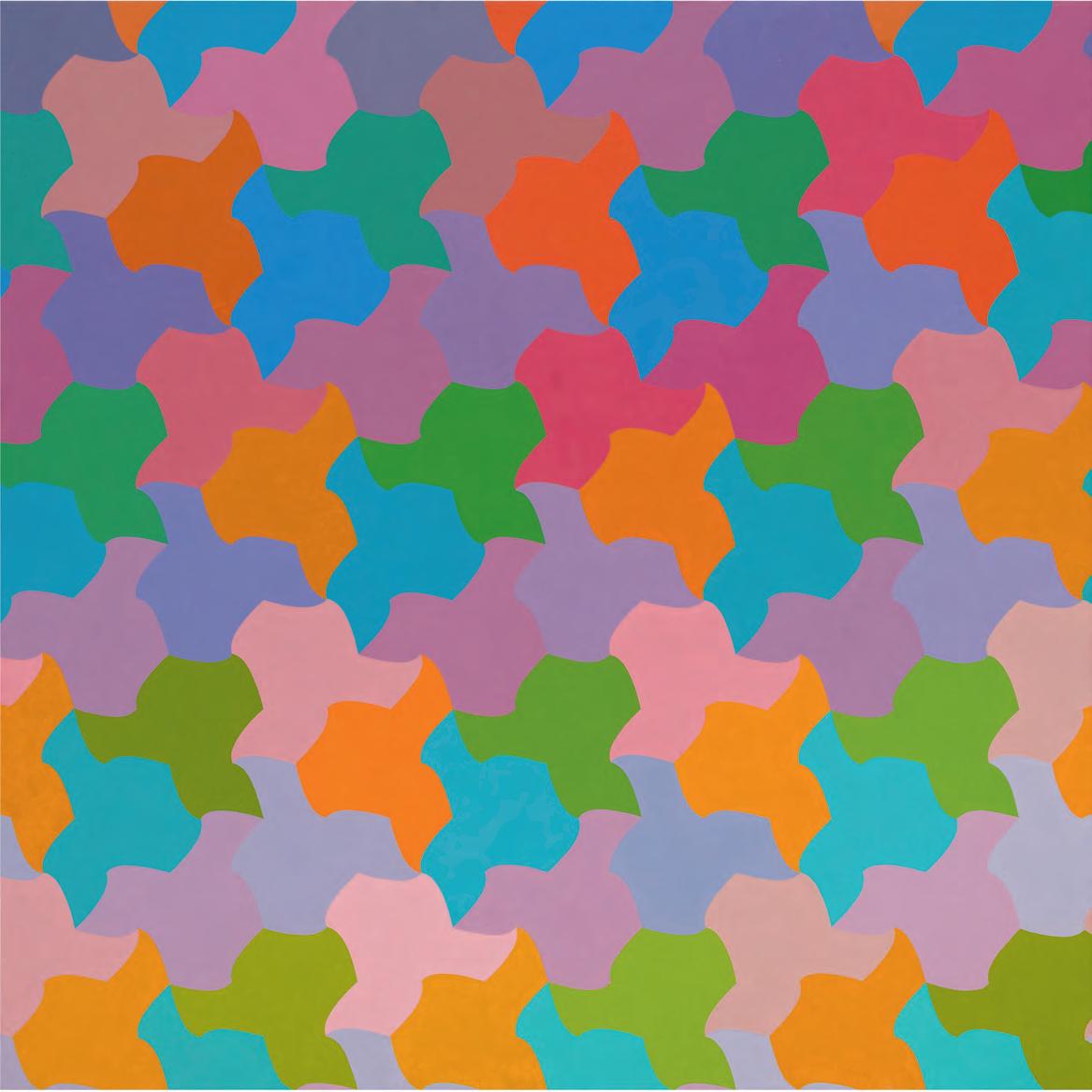
Untitled, 1970 . Acrylic on canvas , 54 x 54 inches
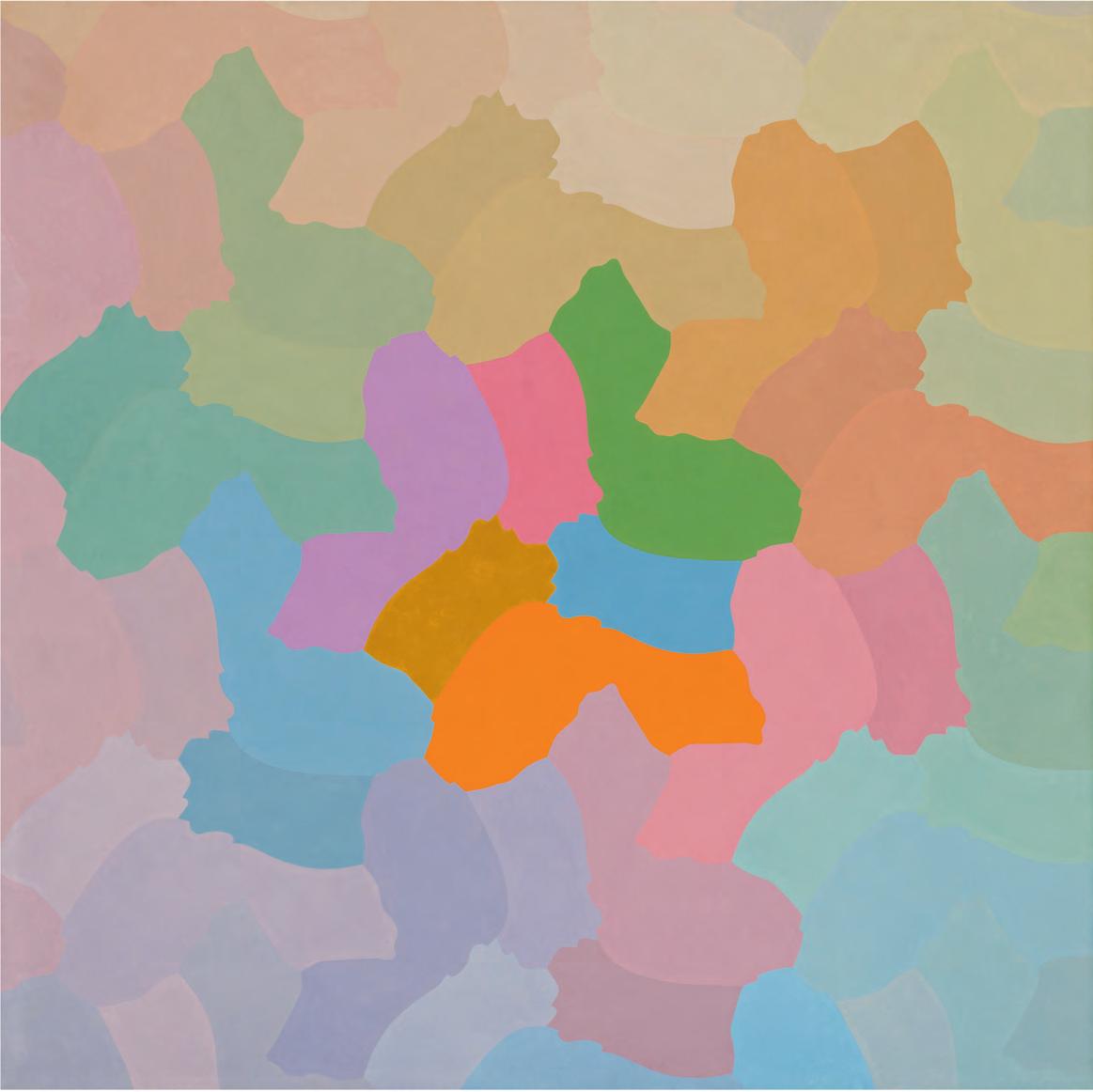
Untitled, 1978 . Acrylic on canvas, 4 9 x 49 inches
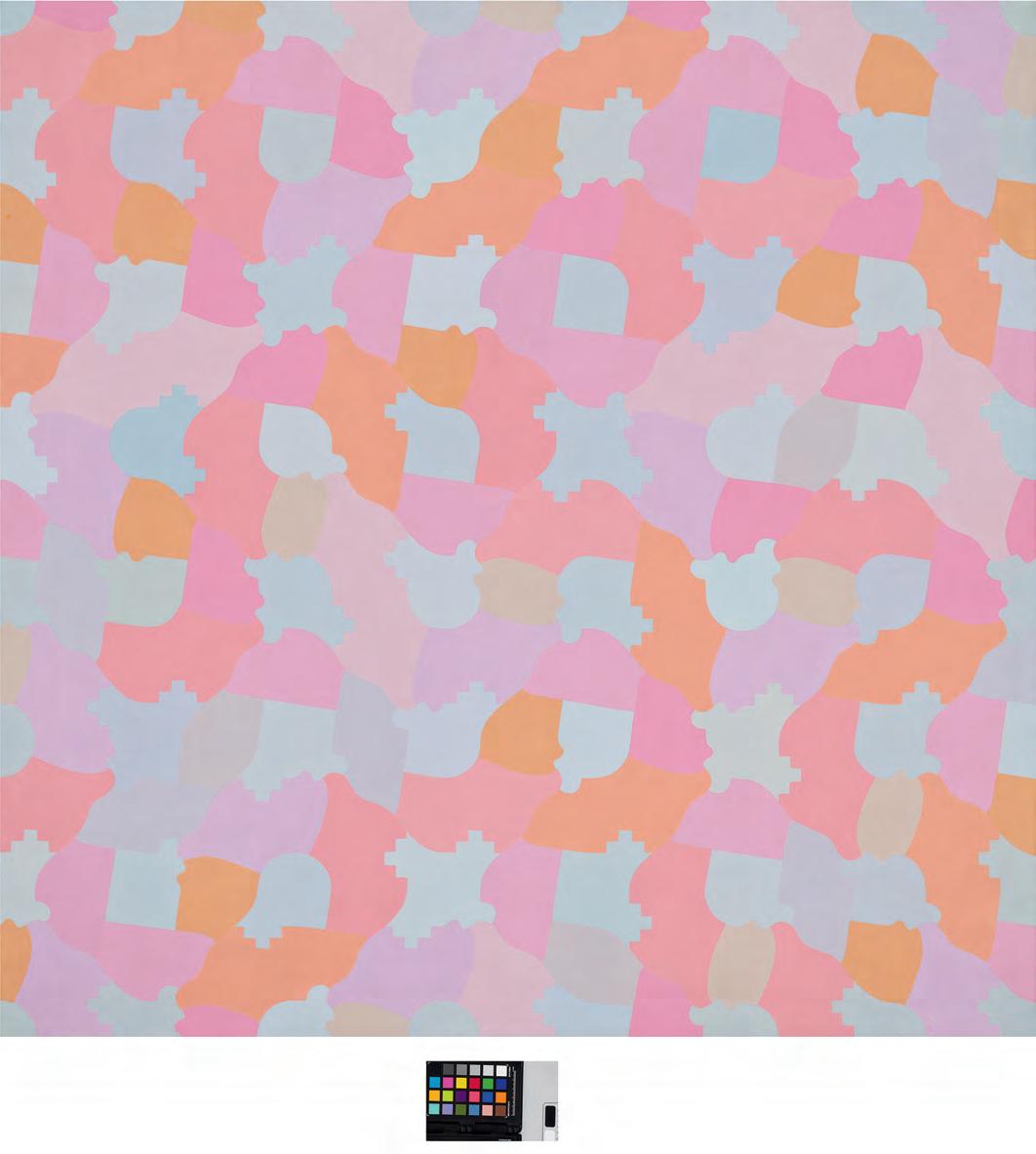
Untitled, c. 19 74 – 76. Acrylic on canvas , 5 9 x 59 inches
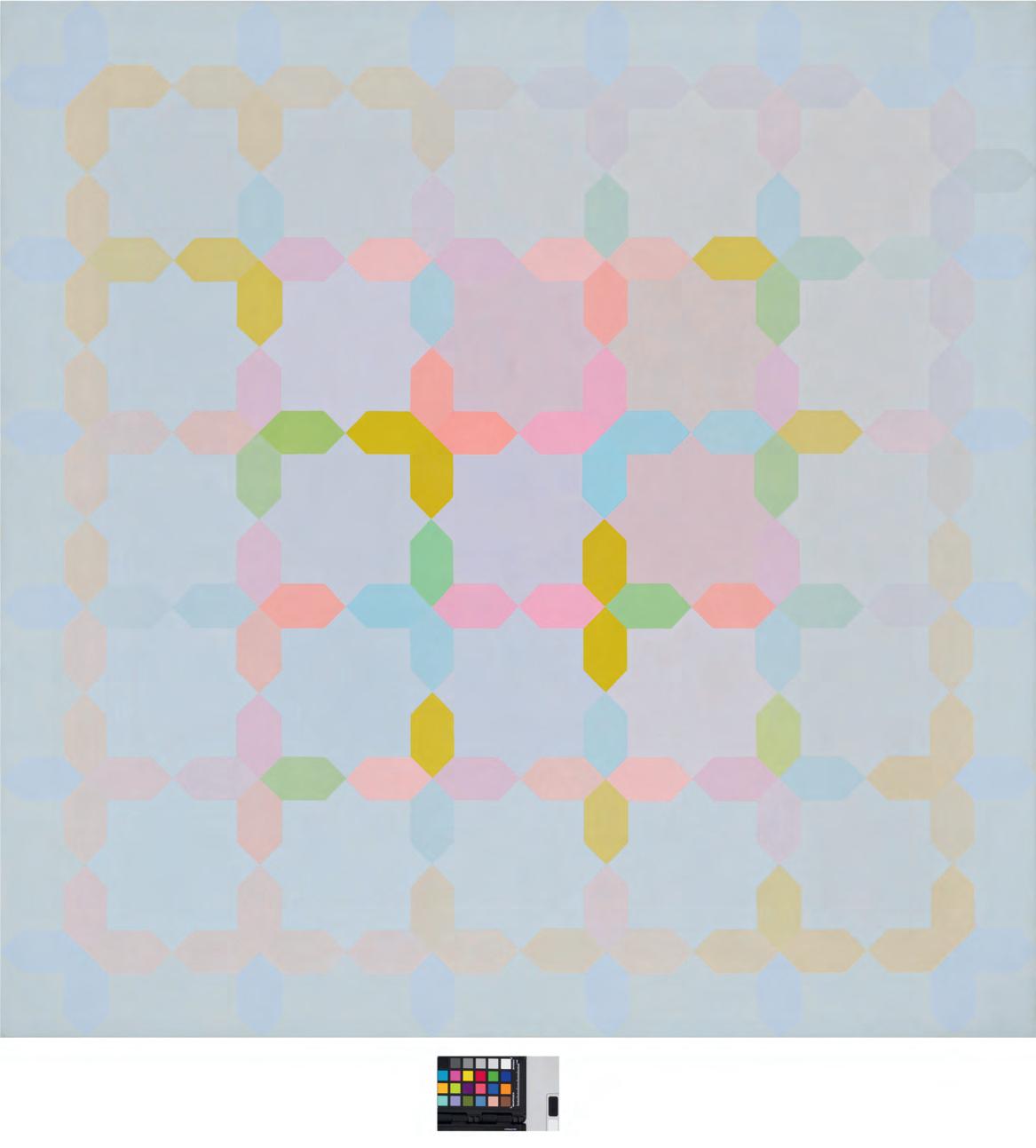
Grey Portal, 1978 . Acrylic on canvas , 84 x 84 inches
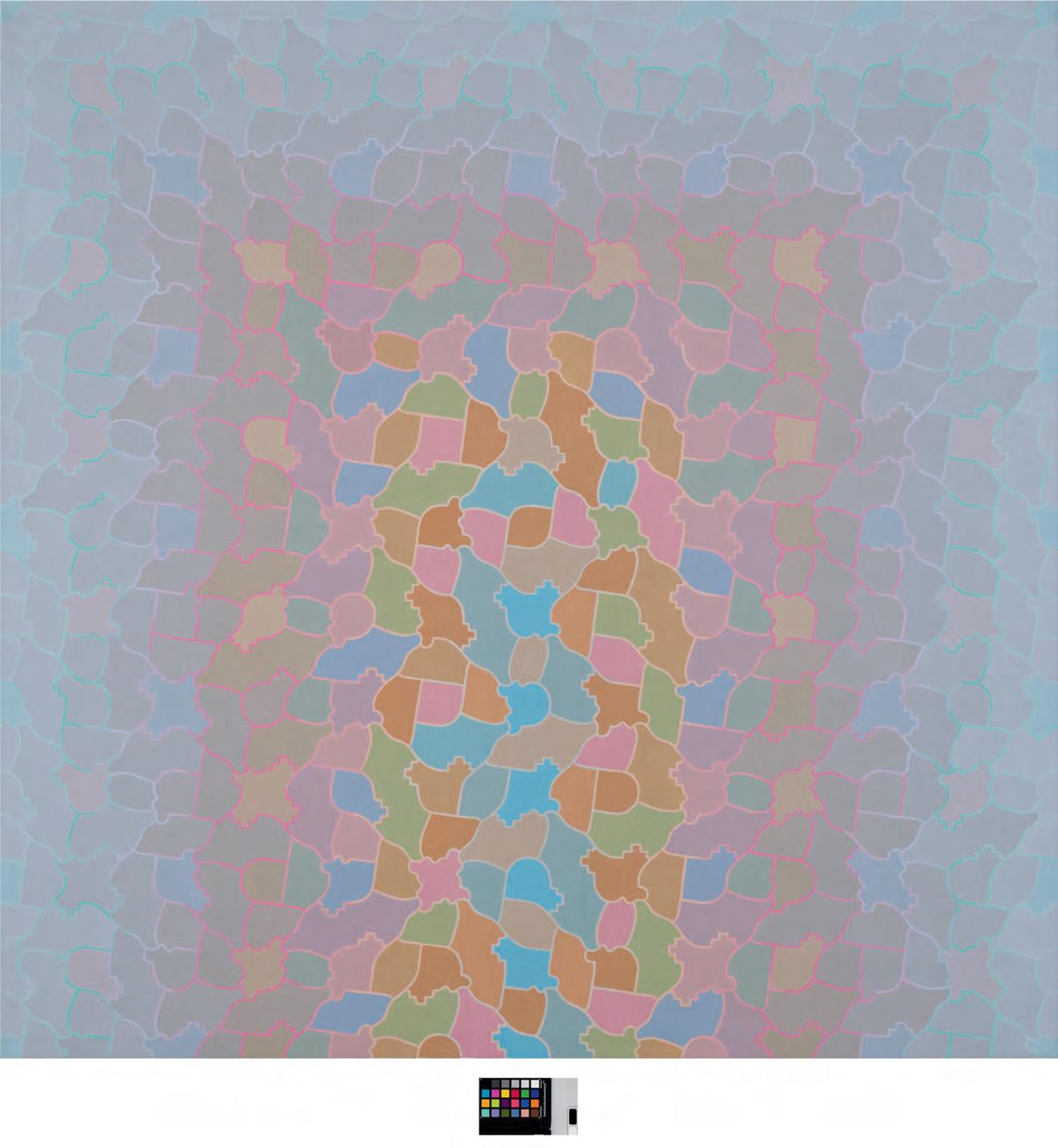
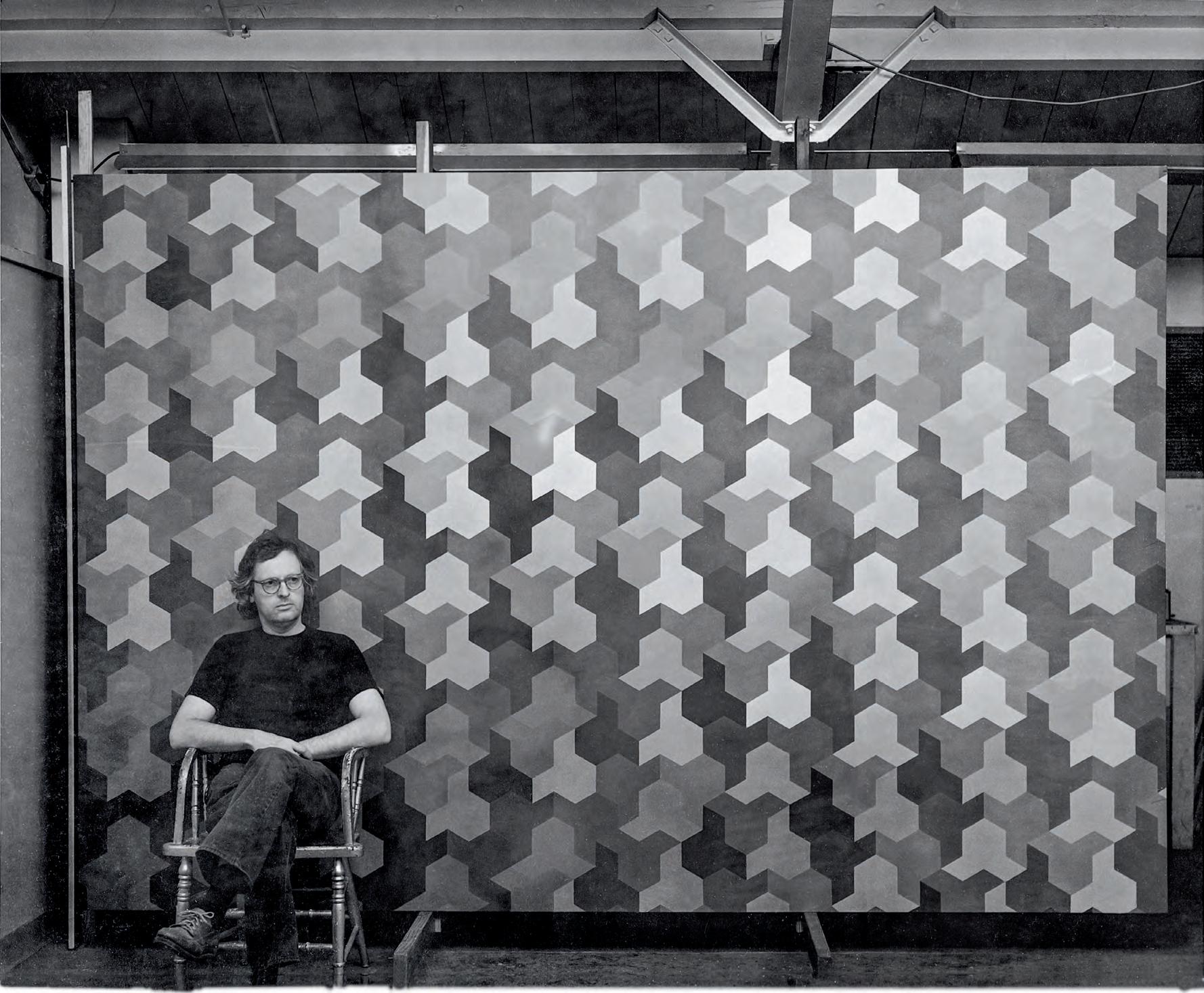
Geo rge Woodman : Statement
Tessellations, patterns made by repeating a shape or group of shapes which fit together to cover a surface, have been fundamental to my work for twelve years. Such patterns place the classic polarity of unity and diversity in a new setting by making possible paintings which have “parts” and yet are the “ same ” everywhere on their surface. In contrast to looser types of pattern, tessellations suppress figure-ground relationships thus emphasizing part to part continuity in favor of part to whole relationships. In this democracy of parts “composition” is sidestepped since the elements have no hierarchical relationship to each other, or a field, beyond their common participation in some combinatorial system which is in principle boundless in extension.
Such patterns have been an invitation to give color a prominent role as a formal element. When structurally the painting is an homogeneous extension of small parts, the control and guidance of attention, the scaling of contrasts, spatial articulation and the development of specific shape identities are all powers granted to the inflection of color. For some years I enjoyed using color and pattern elements in strictly serialized permutational systems. Now I find it more congenial to develop color within these inexorable patterns to ends more idiosyncratic and romantic. The degree of contrast or similarity among shapes, the frequency of their repetition, ease or difficulty of their recognition, intrinsic interest or monotony, ratio of edge to surface plus their absolute size have profound implications for the kind of color experience that can be realized in a painting. In planning new work I usually commence
with a conception of color and develop a pattern which seems appropriate to the kind of total impact sought in the painting
It is an error to confuse the visual interest of patterns with their mathematical, historical, psychological or cultural dimensions. The fact that physical matter is patterned in its spatial order or that use of pattern has been characteristic of some of the traditional arts of women should not suggest that these can be ascribed as significant content to the use of patten in art. My work claims no significance for the use of tessellations beyond the formal and expressive possibilities brought to painting. These are sufficiently challenging to require no extra-artistic web of justification to account for one's interest.
Study of and admiration for Western painting continue to shape my aspirations. Accepting the tradition to define goals and standards for painting, my attitude seems conservative, even conciliatory, however novel the appearance of tessellated paintings may be.
Amy Goldin has coupled a renewed interest in pattern with the possibility of decoration being an alternative to the various strained, hermetic and intellectualized “successors” to art. I see no reason to be offended if my work is viewed as decorative. In the context of the goals of painting, as I perceive them, I might prefer to characterize them as decorous. Decorum in art, like decoration, implies among other things a considerate awareness of the civility of the spectator, his sensibilities, interests and education.
– George Woodman, Criss-Cross
Art Communications #6 , 1978
George Woodman, c. 1970
Geo rge Woodman: Chronology
1932 Born in Concord, New Hampshire
1940-41 Began visiting museums in New England
1945 Attended classes at Manchester Art Institute, Manchester, New Hampshire Decided to become a painter
1946-50 Attended Phillips Exeter Academy, Exeter, New Hampshire
1950-54 Attended Harvard University, Cambridge, Massachusetts. B A with Honors in Philosophy
1951 GROUP EXHIBITION : Fogg Art Museum, Harvard University, Cambridge, MA
1952 GROU P EXHIBITIONS : Lamont Galley, Phillips Exeter Academy, Exeter, NH Busch-Reisinger Museum, Harvard University Cambridge, MA
1952-53 Took evening classes at the Museum School of the Museum of Fine Arts, Boston, MA
1953 Married Elizabeth (Betty) Abrahams. Spent summer in Mexico
1954-56 Attended graduate program in painting at the University of New Mexico. M A. in Fine Arts. Made abstract still life paintings
1955 Son Charles Woodman was born
1956 Moved to Boulder, Colorado to teach theory of art and painting at University of Colorado. Made abstract landscape paintings
SOLO EXHIBITION : George E. Woodman, Lamont Art Gallery, Phillips Exeter Academy, Exeter, NH
1958 Daughter Francesca Woodman was born
1959 GROUP EXHIBITION : Ninth Annual Mid-America Exhibition , Nelson GalleryAtkins Museum, Kansas City, MO
1959-60 First trip to Italy. Rented a house and studio in Settignano, near Florence. Shifted his approach to painting after being heavily influenced by the appearance of the Italian landscape toward abstraction and recalling maps or aerial views.
Cited Diebenkorn, de Kooning, and Guston as influences
1962 SOLO EXHIBITION : George E. Woodman, Chase Gallery, New York, NY
GROUP EXHIBITION : The Art Center, Indiana University, Bloomington, IA
1962-64 Made diamond shaped paintings
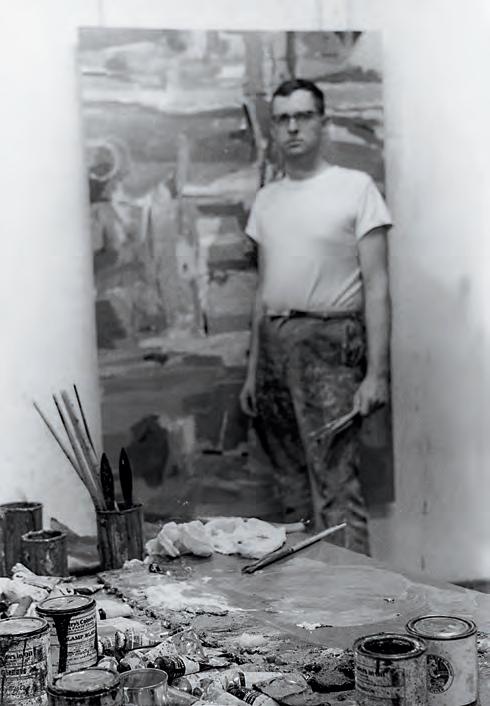
George Woodman in his studio, c 1959- 60
1963 GROUP EXHIBITION : A.C.C. South Central Regional Exhibit , Denver Art Museum, Denver, CO
1964 SOLO EXHIBITION : George Woodman: Paintings 1962-1963, Henderson Gallery, University of Colorado, Boulder, CO
GROUP EXHIBITION : New Work: Paintings and Sculpture , Bridge Gallery, New York, NY
1965 SOLO EXHIBITIONS : Recent Paintings: George Woodman , The Gallery, Denver, CO
George Woodman: Recent Paintings , Bridge Gallery, New York, NY
GROUP EXHIBITIONS : Inter-Mountain Biennial of Painting and Sculpture , Salt Lake Art Center, Salt Lake, UT
Gallery Group, Bridge Gallery, New York, NY
1965-66 Second yearlong trip to Italy. Traveled to Athens and Paris. Visited the Alhambra in Spain to study tile patterns, inspiring a distinctive move to pattern painting. Influenced by Romanesque inlay, the geometry of Alberti and 13th century floor mosaic entitled “Cosmati.” Began compositions based on repeating forms, tessellations, and complex color systems
1966 SOLO EXHIBITION : George E. Woodman: The Italian Paintings , University Memorial Center Art Gallery, University of Colorado, Boulder, CO
GROUP EXHIBITION : Members Gallery, Museum of Modern Art, New York, NY
1967 Received a fellowship from the National Endowment for the Arts
SOLO EXHIBITION : Recent Paintings: George Woodman , The Gallery, Denver, CO
GROUP EXHIBITION : Inter-Mountain Biennial , Salt Lake Art Center, Salt Lake City, UT
1968 Bought a farmhouse in Antella, Italy, outside of Florence. Etablished a studio and began spending part of each year living and working there
SOLO EXHIBITION : Paintings: George Woodman, Spectrum Gallery, New York, NY
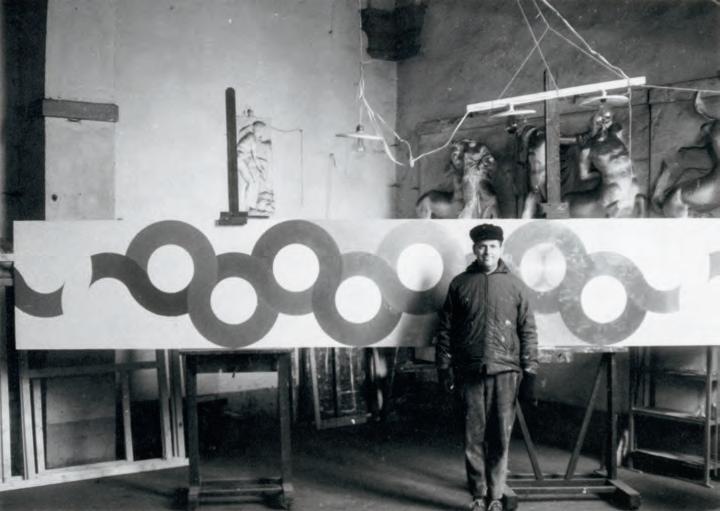
GROUP EXHIBITIONS : National Council on the Arts / National Endowment for the Arts: Award Winning Artists: Southeast and Southwest, Witte Memorial Museum, San Antonio, TX (exhibition catalogue)
Shapes, The Gallery, Denver, Colorador, CO
1969 Traveled to Croatia
SOLO EXHIBITION : Gallery 1309, Boulder, CO
GROUP EXHIBITIONS : Wellesley College Museum, Wellesley, MA
Dayton Museum of Fine Arts, Dayton, OH
1970 Began hexagon tessellation paintings
SOLO EXHIBITION : George Woodman, Spectrum Gallery, New York, NY
GROUP EXHIBITION : Phoenix Gallery, New York, NY
1971 Traveled to Turkey and Athens
SOLO EXHIBITION : Order and Imagery: Paintings 1965-1970, Denver Center Gallery, University of Colorado, Denver
GROUP EXHIBITIONS : Graphics from the Collection of the Marine Midland BankWestern, Albright-Knox Art Gallery, Buffalo, NY
Western Annual, Denver Art Museum, Denver, CO
Betty Woodman & George Woodman , Fine Arts Gallery, Colorado State University, Fort Collins, CO
First Colorado Biennial, Denver Art Museum, Denver, CO, December 18, 1971 –January 30 1972
1972 GROUP EXHIBITIONS : 18th National Print Exhibition , Brooklyn Museum, Brooklyn, NY; traveled to California Palace of the Legion of Honor, San Francisco, CA
1-25 Exhibition , Colorado Springs Fine Arts Center, Colorado Springs, CO
1973-74 Spent the year in Italy. Continued developing pattern and color systems
SOLO EXHIBITIONS : Mostra Personale, Gallerie Sincron, Brescia, Italy
University of Colorado Museum, Boulder, CO
GROUP EXHIBITION : Nebraska-Colorado Exchange, Joslyn Art Museum, Omaha, NE
1974 Criss-Cross a collective of artists concerned with pattern and structure to whom he was a mentor was established in Boulder. He exhibited with them and regularly contributed texts to their publication Criss-Cross Art Communications through 1981. Met and became friends with critic Amy Goldin
SOLO EXHIBITION : George Woodman, Hill’s Gallery, Santa Fe, NM
George Woodman’s studio in Tuscany, 1965
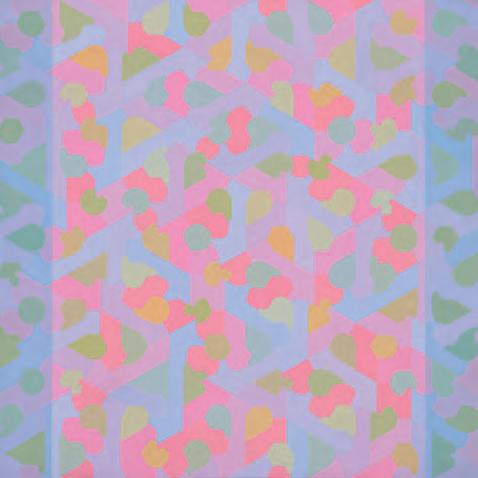
George Woodman, Beauty is Truth, 1976. Acrylic on canvas, 52 x 52 inches. RISD Museum, Providence, Rhode Island. Museum purchase: Helen M. Danforth Acquisition Fund and gift of The Woodman Family Foundation 2021.82 13
1974 GROUP EXHIBITIONS : Five Faculty , University of Colorado Art Museum, Boulder, CO
All Colorado, Denver Art Museum, Denver, CO
Incontra Verifica, Galleria Sincron, Brescia, Italy
Gruppo Sincron, Galleria la Piramide, Florence, Italy
1975-78 Chair of Fine Arts Department, University of Colorado, Boulder, CO
1975 SOLO EXHIBITION : Joseph Magnin Gallery, Denver, CO
1976 SOLO EXHIBITION : Nicholls Fine Art Gallery, Nicholls State University, Thibodaux, LA
GROU P EXHIBITION : Galleria Sergio Rossi, Milan, Italy
1977 GROUP EXHIBITIONS : Patterning and Decoration , Museum of the American Foundation for the Arts, Miami, FL
George and Betty Woodman, U.S.I.S. Gallery, Milan, Italy
ARC, Anonima, Criss-Cross, Art Research Center, Kansas City, MO
Preparatory Notes: Thinking Drawings, Womanspace, Boulder, CO; traveled to 80 Washington Square East Gallery, New York, NY
1978 Began spending one semester each year in New York City. Introduced “nonperiodic” patterns into paintings
SOLO EXHIBITIONS : Sixteen Permutations/ Nine Modules, Bridge Gallery, Boulder, CO
George Woodman/Paintings , The Jasper Gallery, Denver, CO
GROUP EXHIBITIONS : Fifth Colorado , Denver Art Museum, Denver, CO
Criss-Cross, Hillyer Art Gallery, Smith College, Northampton, MA
American Artists, U.S. Consulate, Milan, Italy
1979 Began immersive paper tile installations developed from his “nonperiodic” pattern paintings, realized in a dozen museums and galleries across the U.S. Founding member of Spark Gallery, an artist-run space in Denver, Colorado. Began making freestanding screen paintings. Introduced floral imagery as pattern elements. Traveled to Greece
SOLO EXHIBITION: Three Paper Tilings, Claremore College, Claremore, OK
GROUP EXHIBITIONS: Recent Work, Spark Gallery, Denver, CO
Criss-Cross Pattern Exhibition, 5 E 3rd St, New York, NY; traveled to Denver, CO
Criss Cross. Pattern Project, Boulder Center for the Visual Arts, Boulder, CO
1980 GROUP EXHIBITIONS : Systemic Patterning, Hansen Gallery, New York, NY (exhibition catalogue)
Sixth Colorado Annual , Denver Art Museum, Denver, CO
1980-81 Bought a loft in New York City and established a home and studio for the next four decades. Solomon R. Guggenheim Museum, New York acquired his painting Tessellation Sky (1975). Traveled to Yucatan, Mexico. Death of daughter, Francesca
SOLO EXHIBITIONS : Paper Tilings , University Galleries, Wright State University, Dayton, OH (exhibition catalogue)
George Woodman Watercolors, Hadler/Rodriguez Galleries, New York, NY
George Woodman, Boulder Center for the Visual Arts, Boulder, CO
GROUP EXHIBITIONS : 19 Artists – Emergent Americans, Solomon R. Guggenheim Museum, New York, NY (exhibition catalogue)
Criss-Cross at Yellowstone , Yellowstone Art Center, Billings, MT
Riggors: Exercised for the Spirit , The Patrick Gallery, Austin, TX
Departures in Pattern , Hadler-Rodriguez Gallery, New York, NY
1981-83 Introduced the figure and lattices into pattern painting
SOLO EXHIBITIONS : Paper Tilings , Viterbo College, LaCrosse, WI
Painting and Paper Tile Installation, Haber-Theodore Gallery, New York, NY
Pattern, National Academy of Sciences, Washington, D.C.
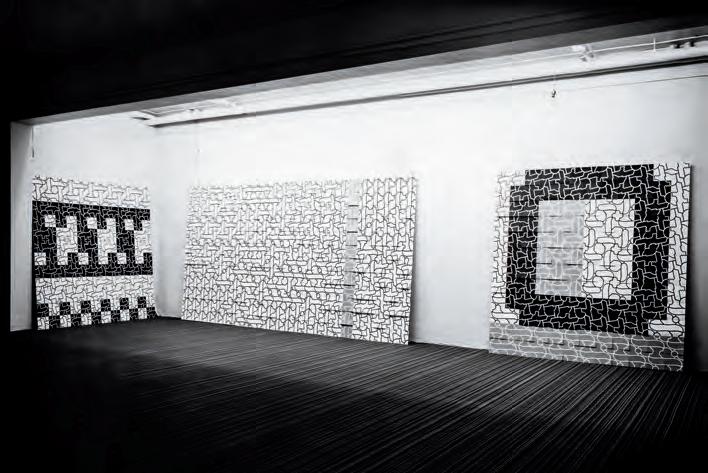
Installation view of George Woodman’s Three Paper Tilings , Claremore College, Claremore, Oklahoma, 1979
GROUP EXHIBITIONS : Three Artists , Spark Gallery, Denver, CO
Partitions, Pratt Manhattan Center Gallery, New York, NY
Development in the Criss-Cross Group , Alain Bilhaud Gallery, New York, NY
Colorado: State of the Arts , Denver Art Museum, Denver, CO
1983 SOLO EXHIBITIONS : George Woodman Paintings , Haber-Theodore Gallery, New York, NY
Paper Tilings, Nelson-Fosdick Gallery, Alfred University, Alfred, NY
GROUP EXHIBITIONS : Criss-Cross en la Ciudad de Mexico, Galeria Pecanins, Mexico City, Mexico
Paper Works, Haber-Theodore Center Gallery, New York, NY
1984 First ceramic tile mural, commissioned for Delavan College Station of the Niagara Frontier Light Rail Transit System, Buffalo, NY
SOLO EXHIBITION : Rochester Carpet, Bevier Gallery, Rochester Institute of Technology, Rochester, NY
GROUP EXHIBITION : 1 + 1 = 2, Bernice Steinbaum Gallery, New York, NY (exhibition catalogue)
1985 Residency at Leighton Artist Colony, Banff Center for the Arts, Banff, Canada. Began figurative paintings
GROUP EXHIBITIONS : Three Artists , Spark Gallery, Denver, CO
Exuberant Abstraction , curated by Peter Frank, 111 Church Street, New York, NY
1986 Residency at The Bemis Project, Omaha, NE. Began shaped canvas paintings. Traveled to Turkey
GROUP EXHIBITION : Contemporary Screens, The Contemporary Arts Center, Cincinnati, OH; traveled to Lowe Art Museum, Coral Gables, FL; City Gallery of Contemporary Art, Raleigh, NC; The Toledo Museum of Art, Toledo, OH; Des Moines Art Center, Des Moines, IA (exhibition catalogue)
1986-87 Contributed exhibition reviews to The Village Voice
1987 Ceramic tile mural commissioned for the Renaissance Center Station, Downtown People Mover, Detroit, MI. Began concentrating on photography. Traveled to India
SOLO EXHIBITION : Fans, Lattices, Flowers, Paintings 1985-86, Ruth Siegel Ltd., New York, NY
1988 GROUP EXHIBITION : Architectural Art: Affirming the Design Relationship, Museum of Contemporary Crafts, New York, NY
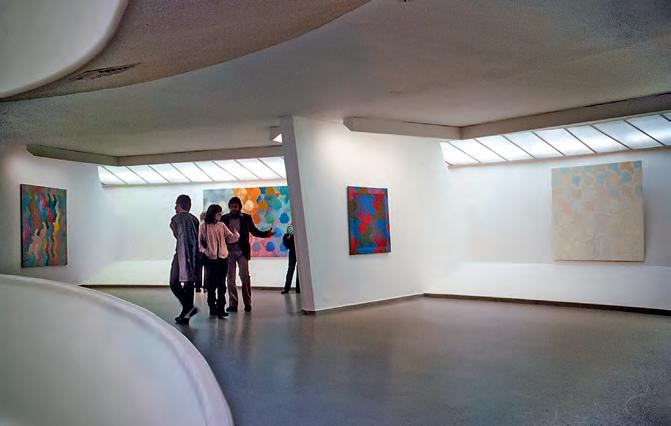
Installation view of paintings by George Woodman in 19 Artists Emergent Americans , Solomon R. Guggenheim Museum, New York, 1981
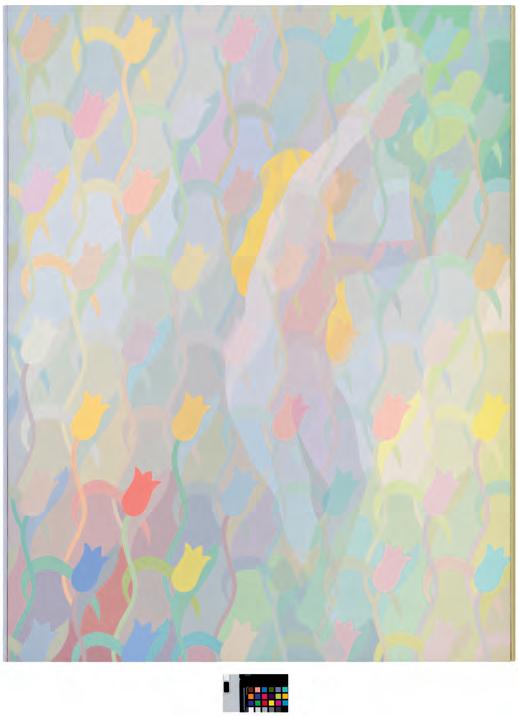
1989 GROUP EXHIBITIONS : A Rain of Talent, Seattle Art Museum, Seattle, WA
New Acquisitions, Denver Art Museum, Denver, CO
1990 Traveled to Turkey
SOLO EXHIBITION : Recent Photographs, Payton-Rule Gallery, Denver, CO
GROUP EXHIBITIONS :
Big Pictures: Contemporary Large Scale Photography, Oliver Art Center, CCAC, Oakland, CA
Shelters and Structures, Rena Branston Gallery, San Francisco, CA
Starting with Landscape, Lieberman and Saul Gallery, New York, NY
1991 Ceramic tile mural commissioned for the Buell Theater, Denver Center for the Performing Arts, Denver, CO. Began working with a camera obscura. Traveled to Japan
SOLO EXHIBITION : Museum Pieces, Barbara Toll Fine Arts, New York, NY
(exhibition catalogue)
GROUP EXHIBITIONS : Visions and Revisions, Denver Art Museum, Denver, CO
Black & White Prints, Lorence/Monk Gallery, New York, NY
1992 GROUP EXHIBITIONS : More Than One Photography, Museum of Modern Art, New York, NY
Midtown Flower Show, Midtown-Payson Gallery, New York, NY
1993 GROUP EXHIBITION : Photographs without Boundaries , Tribeca 148 Gallery, New York, NY
1994 GROUP EXHIBITIONS : Tradition and the Unpredictable: The Allan Chasanoff Photographic Collection, Museum of Fine Arts, Houston, TX (exhibition catalogue)
Some Photographs We Like, Bonni Benrubi Gallery, New York, NY
’93 Wishes and Greetings for ’94, Bernice Steinbaum Gallery, New York, NY
Summer Exhibition, Julie Saul Gallery, New York, NY
Not Giving Up the Ghost , Tribeca 148 Gallery, New York, NY
La Grande Mela in Toscana, Museo Archeologico, Cortona, Italy
1995 Retired from teaching at University of Colorado. Began splitting time between New York and Antella
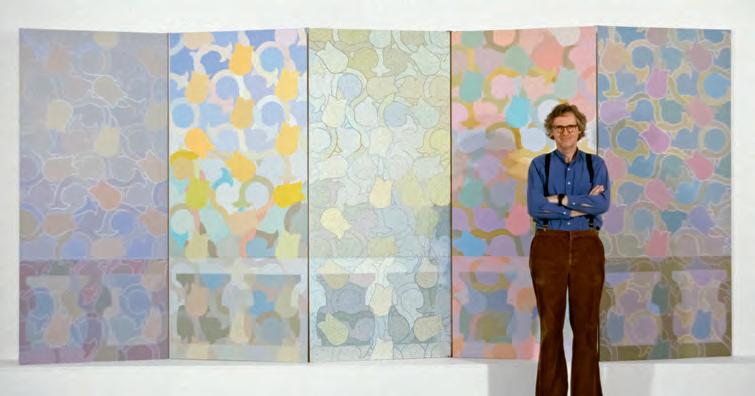
George Woodman with his painting Garden with Balustrade or The Grand Screen , 1979 Acrylic on canvas, 84 x 180 inches
George Woodman, Daphne, 1982. Acrylic on canvas, 78 x 60 inches
1996 Published the first of several artist’s books of photographs, Museum Pieces, with an essay by Max Kozloff
1997 Traveled to Puebla, Mexico
SOLO EXHIBITIONS : George Woodman, Museo Universitario, Puebla, Mexico
Pitti Rivisitato: Fotografie di George Woodman, Palazzo Pitti, Florence, Italy (exhibition catalogue)
George Woodman, Dryphoto Arte Contemporanea, Prato, Italy
GROUP EXHIBITIONS : Im Reich der Phantome, Fotografie des Unsicht baren, Stadtisches Museum, Monchengladbach, Germany
Light Tracings, Hatton Gallery, Colorado State University, Fort Collins, CO
1998 SOLO EXHIBITIONS : True Pictures of False Women, Palazzo della Torre, Greve, FIorence, Italy
George Woodman: Sensuality in a World of Reason , Boulder Museum of Contemporary Art, Boulder, CO (exhibition catalogue)
1999 Traveled to Mexico City
SOLO EXHIBITION : Imagenes de tiempo, sensibilidad y sombra , Museo
Universitario del Chopo, Mexico City, Mexico
GROUP EXHIBITIONS : New Acquisitions 1998 Exhibition , Portland Museum of Art, Portland, ME
Salone della Fotografia Storica Moderna e Contemporanea , Palazzo Querini
Dubois, Venice, Italy
2000 G ROUP EXHIBITION : Memory and Material: Constructions and Compilations , DC Moore Gallery, New York, NY
2001 Traveled to Thailand, Cambodia and Korea
SOLO EXHIBITION : George Woodman, Cento Giovanni Lotti, Mercatale Val di Pesa, Florence, Italy
GROUP EXHIBITIONS : Between Earth and Heaven: New Classical Movements in the Art of Today , Museum Voor Moderne Kunst, Ostend, Belgium (exhibition catalogue)
Dreaming, Kauffman and Rosenberg, New York, NY
2002 GROUP EXHIBITIONS : Truths & Fictions , Amethyst, Chennai, India
Materie Recuperati, Asolo, Italy
2003 Traveled to and taught in Chennai, India
GROUP EXHIBITION : The LAPD Project: The Legacy of Pattern and Decoration , Shoshana Wayne Gallery, Los Angeles, CA
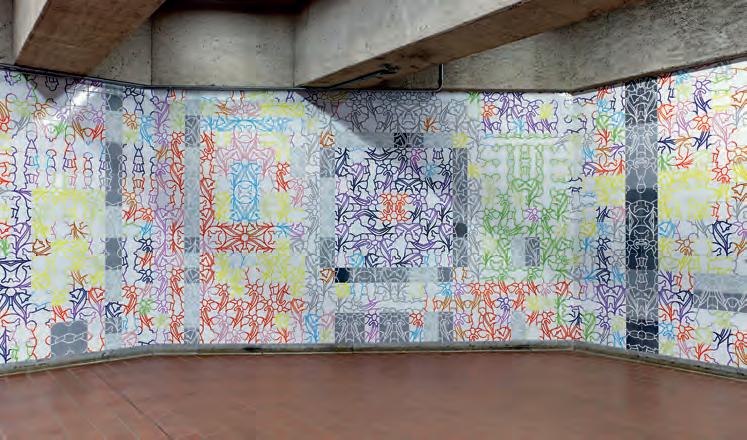
George Woodman, Untitled , 1984. Ceramic tile installation. Public commission at the Delevan College Station of the NFTA System, Buffalo, New York
2004 Residency at Grand Arts, Kansas City, MO. Completed a second ceramic tile mural for the Renaissance Center Station, Downtown People Mover, Detroit, MI to replace the one made in 1987 that was destroyed during station renovation
SOLO EXHIBITION : Camera Obscura Photographs, Grand Arts, Kansas City, MO (exhibition catalogue)
2005 Began painting on photographs
2006 Traveled to Korea
GROUP EXHIBITIONS : The Armory Group: 40 Years, Mizel Center for Arts and Culture, Denver, CO
Francesca Woodman, George Woodman, Galerie Clara Maria Sels, Düsseldorf, Germany
Couples Discourse, Palmer Museum of Art, University Park, PA (exhibition catalogue)
2007 SOLO EXHIBITION : George Woodman: Paintings 1960 -2000, Bemis Center for Contemporary Arts, Omaha, NE (exhibition catalogue)
GROUP EXHIBITION : Geometrics, Gallery 128, New York, NY
2008 Traveled to China
2010 Received the National Artist Award, Anderson Ranch, Snowmass, CO
SOLO EXHIBITION : How a Picture Grows a World, Galleria Bagnai, Florence, Italy (exhibition catalogue)
GROUP EXHIBITION : Exposure: Photos from the Vault , Denver Art Museum, Denver, CO
2011 SOLO EXHIBITION : Nati Digitali O Diventuti Tali, Centro Espositivo Antonio Berti, Sesto Fiorentino, Italy
GROUP EXHIBITION : Behind the curtain, a lock of hair falling , Gallery Diet, Miami, FL
2012 SOLO EXHIBITION : Heroines , Galleria Bagnai, Florence, Italy (exhibition catalogue)
2014 GROUP EXHIBITIONS : Cut to Swipe, Museum of Modern Art, New York, NY
Currier Museum Art Center’s 75th Anniversary! , Currier Museum of Art, Manchester, NH
Contrapposto & Other Stories , Jeff Bailey Gallery, New York, NY
2015 Traveled to Brazil
2016 SOLO EXHIBITION : George Woodman: Photographs, Nina Freudenheim Gallery, Buffalo, NY
2017 Died at home in New York City
2018 GROUP EXHIBITIONS : Pattern, Crime, and Decoration, Musée d’Art Moderne et Contemporain, Geneva, Switzerland; traveled to Le Consortium, Dijon, France (exhibition catalogue)
Systemic Pattern Painting: Artists of the Criss-Cross Cooperative, David Richard Gallery, New York, NY
2019 GROUP EXHIBITION : Les Chemins du Sud, Musée Régional d’Art Contemporain (MRAC) Occitanie, Serignan, France
2023 GROUP EXHIBITION : Betty Woodman and George Woodman , Lewes, East Sussex, England
2024 GROUP EXHIBITION : Who Is There?, DC Moore Gallery, New York, NY
2025 SOLO EXHIBITION : George Woodman: A Democracy of Parts, Paintings 1966-1978, DC Moore Gallery, New York, NY
SELECTED PUBLIC COLLECTIONS
Brooklyn Museum, Brooklyn, New York
Colorado State University, Fort Collins, Colorado
Currier Museum of Art, Manchester, New Hampshire
Denver Art Museum, Denver, Colorado
Houston Museum of Fine Arts, Houston, Texas
Lamont Gallery, Exeter, New Hampshire
Museum of Modern Art, New York, New York
Portland Art Museum, Portland, Maine
Remo Brindisi House Museum, Lido Di Spina, Italy
RISD Museum, Providence, Rhode Island
Solomon R. Guggenheim Museum, New York, New York
Museo Universitario del Chopo, Mexico City, Mexico
University of New Mexico, Albuquerque, New Mexico
Utah Museum of Contemporary Art, Salt Lake City, Utah
Whitney Museum of American Art, New York, New York
Yale University Art Gallery, New Haven, Connecticut

George Woodman, Jessica Episodic on the Rug , 2003. Gelatin silver print, 30 x 40 inches
BIBLIOGRAPHY
MONOGRAPHS AND SOLO EXHIBITION CATALOGUES
Bagnai, Alessandro. Heroines . Florence: Galleria Alessandro Bagnai, 2013
Berlind, Robert. George Woodman: Paintings 1960-2000. Omaha: Bemis Center for Contemporary Arts, 2006
Frank, Edwin. Pitti Rivisitato. Florence: Centro Di, 1997
Lowery, Rebecca Skafsgaard. George Woodman: A Democracy of Parts, Paintings
1966-1978 New York: DC Moore Gallery, 2025
Paglia, Michael. George Woodman: Sensuality in a World of Reason . Boulder: Boulder Museum of Contemporary Art, 1998
Princenthal, Nancy. George Woodman: The Camera Obscura Photographs
Kansas City: Grand Arts, 2004
Paper Tilings by George Woodman Dayton: Wright State University Galleries, 1982
A R TI S T ’S BOOKS
Woodman, George, and Edwin Frank. The Further Adventures of Pinocchio . New York: Lo Specchio d’Arte, 2004
Woodman, George, and Iris Cushing. How a Picture Grows a World. Florence: Galleria Alessandro Bagnai, 2010
Woodman, George Metaphysics is to Metaphor as Cartography is to Departur e.
Florence: Galleria Alessandro Bagnai, 2011
Woodman, George, and Max Kozloff. Museum Pieces: Photographs by George Woodman. New York: Lo Specchio d’Arte, 1996
SELECTED OTHER BOOKS AND CATALOGUES
Butera, Virginia Fabbri. Contemporary Screens. Washington, D.C.: National Gallery of Art, 1986
Ewing, William. The Body: Photoworks of the Human Form . London: Thames and Hudson, 1994, p 384
Eyemazing Susan. Eyemazing: The New Collectible Art Photography . London: Thames & Hudson Ltd, 2013
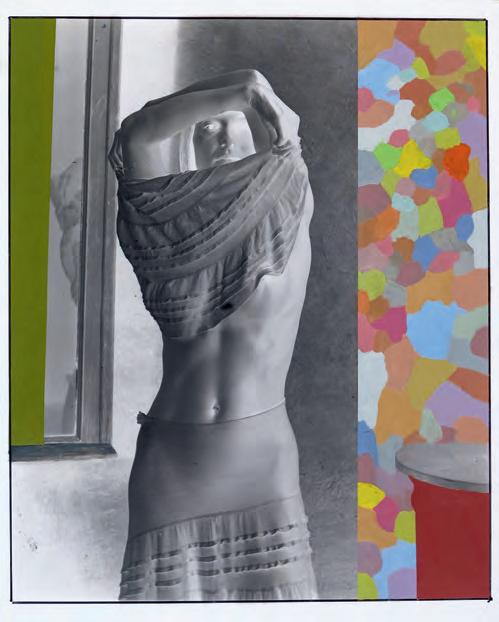
George Woodman, Saskia Designed a Dress , 2006. Oil paint on gelatin silver print, 20 x 16 inches
Frank, Peter. 19 Artists – Emergent Americans. New York: Solomon Guggenheim Museum, 1981
Gautherot, Franck and Kim Seungduk. Pattern, Crime & Decoration. Paris: Les Presses du Réel, 2020
Goldin, Amy. Patterning and Decoration . Miami: Museum of the American Foundation for the Arts, 1977
Katz, Anna. With Pleasure: Pattern and Decoration in American Art 1972-1985 . Los Angeles: The Museum of Contemporary Art, 2019
Komanchy, Michael and Virginia Butera. The Folding Image . Washington, D.C.: National Gallery of Art, 1984
Kuspit, Donald, and Melinda Wortz. One + One. Boca Raton: Boca Raton Museum of Arts, 1984
Perrault, John. Partitions. Brooklyn: Department of Exhibitions, Pratt Institute, 1982
Walt, Irene. Art in Stations: the Detroit People Mover . Detroit: Wayne State University Press, 2004
SELECTED ESSAYS AND REVIEWS
Adamson, Glenn. “Pattern Recognition: In the 1970s and ‘80s a bold group of American artists embraced vibrant color, ornament, and craft.” Art in America, September 2019
Aletti, Vince. “Voice Choices,” The Village Voice , December 31, 1991
Ashbery, John. “An Exhilarating Mess,” Newsweek, March 1981
Barreiro, Raul. “Refelja en fotos recuerdo y dolor,” Reforma, April 28, 1999
Barsantini, Betty. “George Woodman, Heroines,” TG Toscana Edizione delle 19.30, RAI TV 1, January 2013
Binazzi, Lapo. “Accordi di Colore e Amonie di Forme,” Keramikos, February 1991, pp. 58- 61
Bortolotti, Paola. “Una Bi-Personale: George Woodman e Manfred Bishop,” Stamp Toscana, November 22, 2012
Braithwaite, Hunter. “Behind the curtain, a lock of hair falling,” Artforum, September 2011
Budney, Jen “ George Woodman at the Palazzo Pitti,” Art in America, February 1998
Bullock, Linda. “Tile Art Reborn: People Mover Stop to Re-open at RenCen,” Detroit Free Press, November 17, 2004
Chandler, Mary Voelz. “Work that Fits a Timeless Pattern,” Rocky Mountain News, March 15, 1998
Clurman, Irene. “George Woodman,” Arts Magazine, April 1982
Collins, Betty. “New Work: George Woodman,” Arts Magazine, May 1981
Diez, Hector Leon “Imagio escenarios y realizo construcciones completas de una imagen a traves de la fotografia: George Woodman,” La Cronica, April 28, 1999
Eyemazing Susan, ed., and Clayton Maxwell. “George Woodman,” Eyemazing 4 (2012)
Glueck, Grace. “The Screen Comes into Its Own,” New York Times, September 19, 1982
Glueck, Grace. “Uptown, It’s Couples,” New York Times, February 17, 1984
Hagen, Charles. “Art in Review,” New York Times, December 27, 1991
Krainak, Michael Joe. “Visual Legacy: Bemis Center retrospective celebrates 40 years of Woodman paintings,” Omaha City Weekly, March 7, 2007
Kumar, Rahul. “Betty Woodman and George Woodman showcase works at Charleston Gallery,” STIR, March 26, 2023
Lubell, Ellen. “George Woodman: Watercolors,” Art in America, Summer 1981

George Woodman, Calci with Landscape I , 1993 Gelatin silver print, 24 x 20 inches
Martinez, Miriam Mabel. “Otra manera de contemplar el tiempo: Cuando la vista no es suficiente,” Orgina, May 1999
McKean, N. “The Art of Living,” New York Magazine, April 6, 1981
Montanari, Laura. “George Woodman, la fotografia come un lungo fiume di classicità,” La Republica , November 23, 2012
Parlato, Frank. “George Woodman Photographs,” Artvoice, April 14, 2016
Patalay, Ajesh. “Betty and George Woodman, platter artists,” Financial Times, February 26, 2023
Rebora, Simone. “La mise en abyme del corpo femminile,” Artribune, January 14, 2013
Sikes, Gini. “Pattern and Place,” Metropolis , October, 1984, pp. 17–19, 26
Wildman, David. “Betty, Charlie, Francesca, and George,” TimeOut Boston, December 6, 2010
“A Closer Look,” The New York Art World, February 1999
“Fotosensible: Composiciones y dialogos de Woodman,” El Heraldo, May 9, 1999
“George Woodman: come la nostra arte ha influito sul lavoro di Francesca,”
Maldetti Fotografi, June 3, 2014
“George Woodman, Heroines,” Wall Street International Magazine, January 15, 2013
“Immagini da un altro Pitti,” La Repubblica, July 8, 1997
“Italian Design: Florence,” Interni, May 1986
“Keramikbilder von George Woodman Im Theater von Denver (USA),” Mit Fliesen Leben, 1993, cover, pp. 22- 45
“Panello Artistico Progetto George Woodman,” Domus, April 1989
ARTIST’S WRITINGS
“Statement,” Criss-Cross Art Communications #6, 1978
“Artist Statement,” Criss-Cross Art Communication: The Criss-Cross Pattern Project no. 10, 1979
“Pattern,” Criss-Cross Art Communication: The Criss-Cross Pattern Project no. 10, 1979
“Ceramic Decoration and the Concept of Ceramics as a Decorative Art,” American Ceramics 1.1, Winter 1982
“The Decorative Vessel,” Ceramic Echoes. Kansas City: Nelson Gallery, 1983
“Why (Not) Ceramics?,” New Art Examiner 13.1, September 1985
“Gulliver in the Garden,” The Village Voice, November 3, 1986
“Mimbres Only,” The Village Voice , January 28, 1986
“The Problem of Color in Ceramics,” The Studio Potter 14.2, June 1986
“Getting Your Word’s Worth,” The Village Voice, December 1987
“Sic Transit Gloria Storrs,” The Village Voice , January 1987
“Unified Perspective,” The Studio Potter 23.1 (Dec. 1994): 3
“Joy Walker,” Joy Walker Recent Paintings, New York: 55 Mercer Gallery, 1995
Scott Chamberlin: Recent Sculptures, Boulder: Boulder Arts Center, 1995
“Prints from Shark’s Inc,” Working Proof, Boulder: University of Colorado Art Galleries, 1996
“Ceramics and the Biography of Vision,” The Studio Potter 17.1, December 1998
“Clare’s Language,” Incoming Tide: Works by Clare Chandler Forster , Minneapolis: Minnesota Center for Book Arts, 1998
“The Art of Sydney Biddle,” Sydney Biddle: Some Paintings, Monotypes, Drawings, 1999
“In Her Studio: The Art of Betty Woodman,” Betty Woodman: Between Sculpture and Painting. Fort Dodge: The Blanden Memorial Art Museum, 1999
“The Paintings of Margaretta Gilboy,” Between Heaven and Earth, Philadelphia: The Philadelphia Art Alliance, 1999
“Portfolio — George Woodman,” Fotophile no. 33, Autumn 1999
“The Unknown Matisse by Hilary Spurling,” The Readers Catalogue, 1999
“Some Photographs of Photographs.” The Ohio Review 60, January 2000, pp 65-97
“The Life of Things in the Eye and the Mind of Americans.” Through American Eyes: Two Centuries of American Art from the Huntington Museum of Art, Huntington: Huntington Museum of Art, 2003
“The Armory Group: 40 Years,” Denver: Mizel Center for the Arts and Culture, 2006
“The Significance of Investing Industrial Profit into Fine Arts,” International Architectural Ceramic Conference, Gimhae: ClayArch Gimhae Museum, 2006
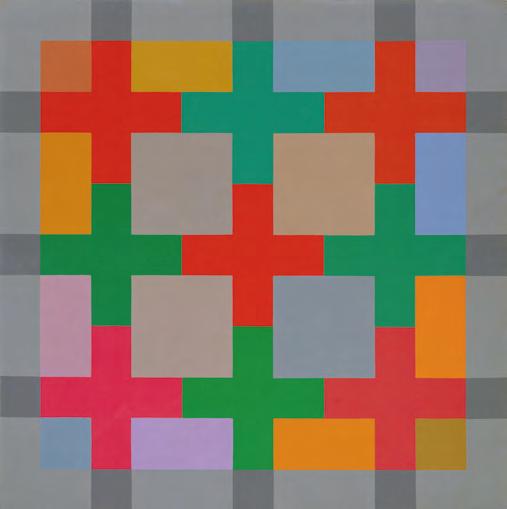
George Woodman, Untitled , c. 1966- 68. Acrylic on canvas, 39 1 2 x 39 1 2 inches. Currier Museum of Art, Manchester, New Hampshire, 2024.46
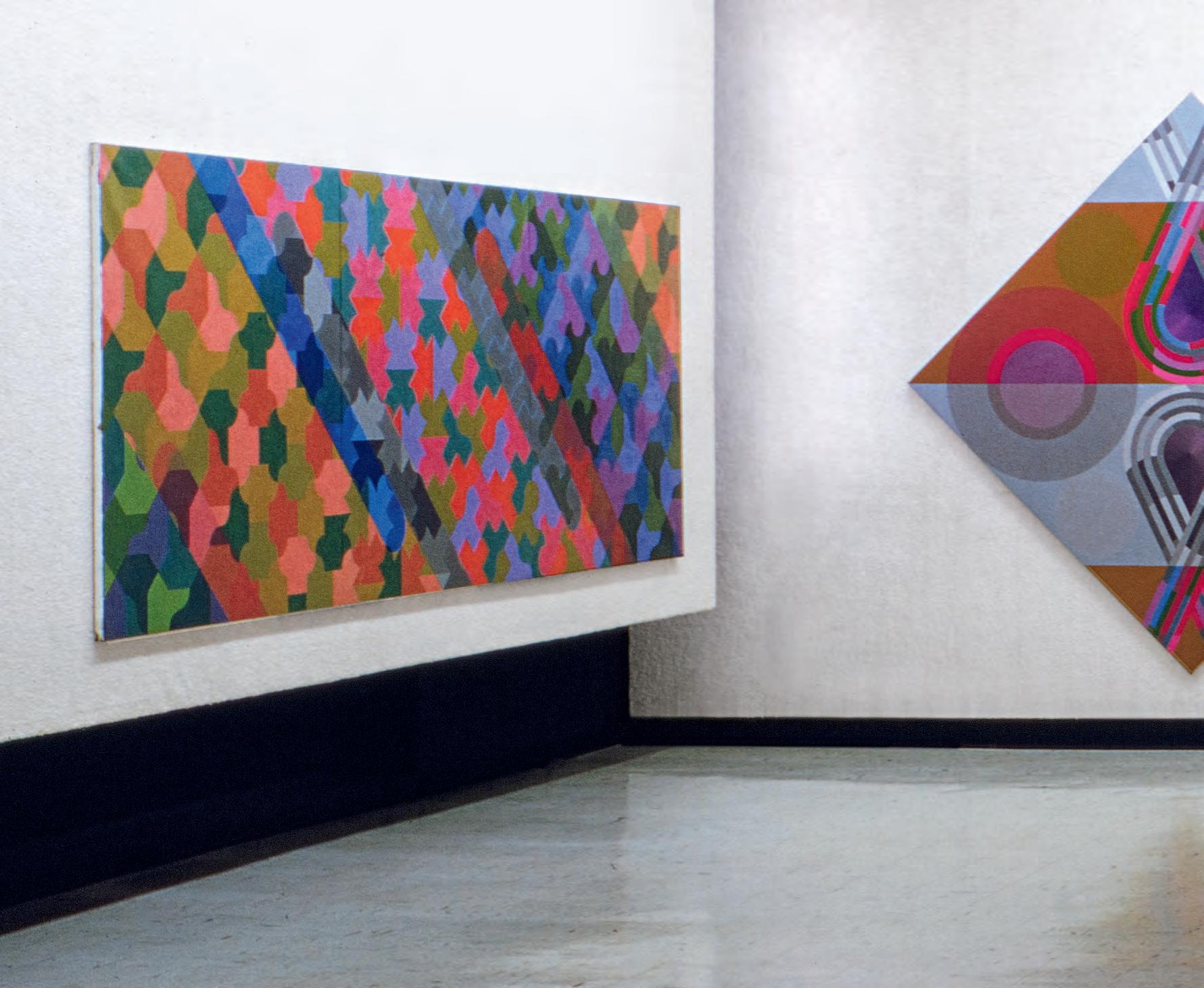
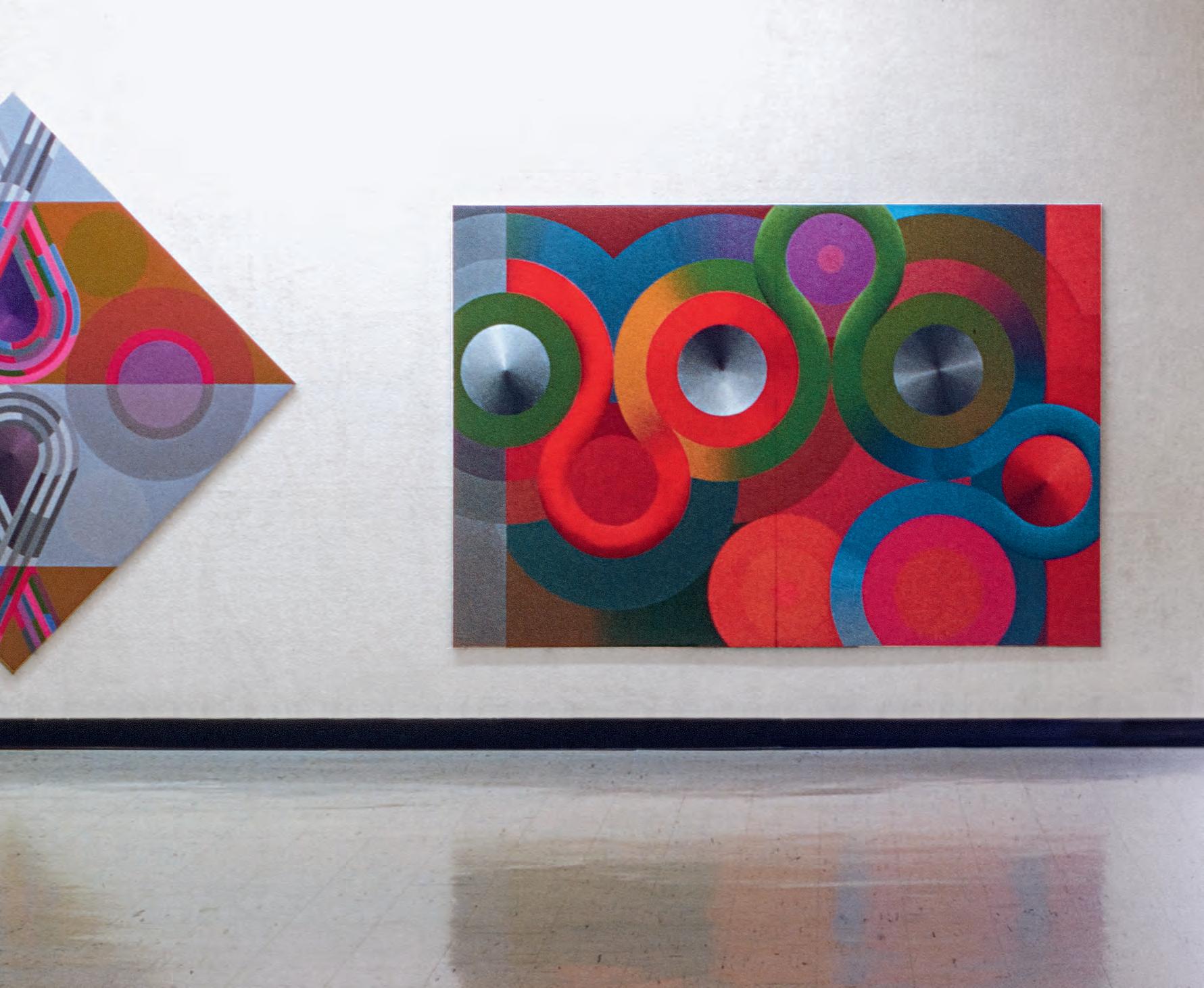
D C MOOR E GALLE R Y
535 W est 22 Street New York , New York 1 0 011
21 2 . 24 7. 2 111 dcmooregallery.com
This catalogue was published on the occasion of the exhibition
GEORGE WOODMAN
A Democracy o f Parts: Paintings 196 6 -1978
DC Moore Galler y, April 3 – May 3, 2025
Catalogue © DC Moore Galler y, 2025
THE MIND AS IT MEASURES : George Woodma n’s Patterns
© Rebecca Skafsgaard Lower y, 2025
ISBN : 9 7 8 -1- 7 367 7 2 3 - 9 - 3
All archival images courtesy Woodman Family Foundation Archive. All artworks, drawings and writings by George Woodman © Woodman Family Foundation / Artists Rights Society (ARS), Ne w York.
Design: Joseph Guglietti • Printing: Brilliant • Principal photography © Steven Bates
P 7, TOP : © The Museum of Modern Art / Licensed by SCALA / Art Resource, NY
P P 58 /59 : I nstallation view from George E. Woodman: The Italian Paintings , University Memorial Center Art Gallery, University of Colorado, Boulder, 1966
